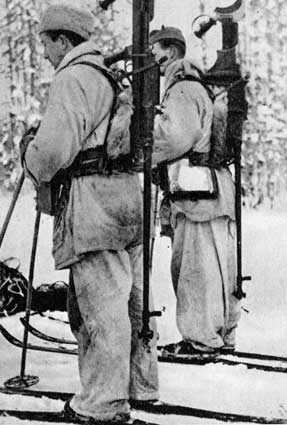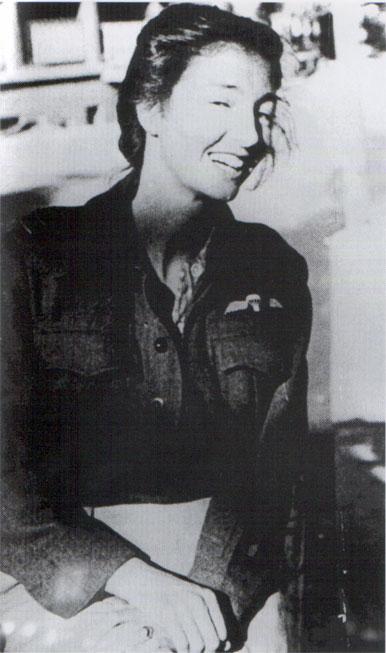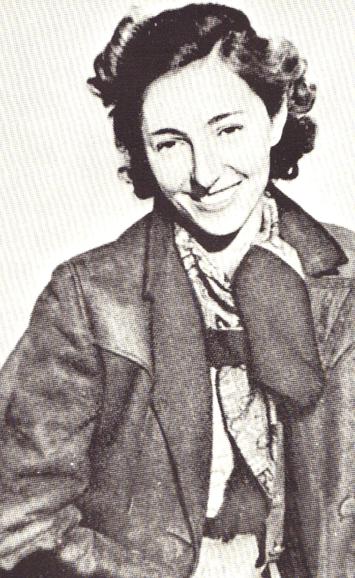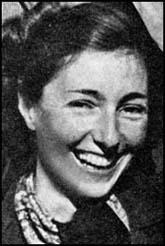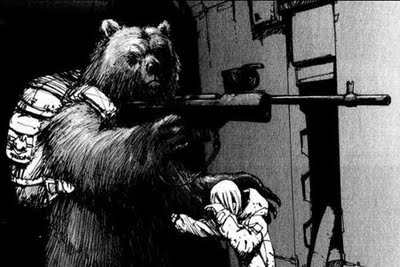UPDATED 28 February 2011
Tank Terror 1: the Pedestrian Infantry's Refusal to Adapt to Anti-Tank Warfare
By
Mike Sparks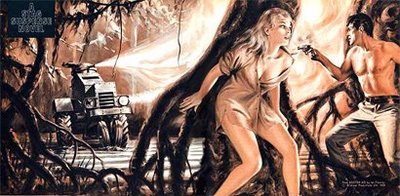
James Bond is For Real
In Dr. No, former British Naval Intelligence Division (NID) and reserve Commander Ian Fleming has James Bond, Honey Ryder and the native guide Quarrel confronted by an armored vehicle guarding a secret installation. Bond fires his small .32 caliber [7.65mm] Walther PPK pistol exchanged in the beginning of the story over the even less powerful .25 caliber Beretta--to little effect against the tank's headlights.
 www.youtube.com/watch?v=VuO34MDezzU
www.youtube.com/watch?v=VuO34MDezzU
A flame-thrower incinerates Quarrel so Bond and Ryder surrender to men that dismount from the "dragon" vehicle and take them back to Dr. No's underground base.
 www.youtube.com/v/k7NicCWUtmY
www.youtube.com/v/k7NicCWUtmY
One of the main themes of Dr. No is not to be out-gunned; but walking infantry is nearly always overmatched on the modern battlefield where the enemies make full use of machines. In later stories, like "The Living Daylights", and "For Your Eyes Only" Fleming has Bond with more powerful weapons that can destroy their targets as well as keep him at a safe stand-off. At the end of Diamonds are Forever, Anti-Tank Rifles
 www.youtube.com/watch?v=4njAvCleiXM
www.youtube.com/watch?v=4njAvCleiXM
The first anti-tank reaction beyond pointing direct-fire field guns at them was to create large caliber anti-tank rifles shooting bigger bullets to poke holes in their at first thin armor. In typical cliche-making, the tanks got heavier and thicker and the AT rifles became useless. This cliche does not fit the facts of what happened. After WW1, AT rifles were continually developed to ward off enemy tanks; the 35-pound, Boys AT rifle being the most prolific example that was issued with nearly Bren gun AKA Universal carrier in WW2.
http://en.wikipedia.org/wiki/Boys_anti-tank_rifle
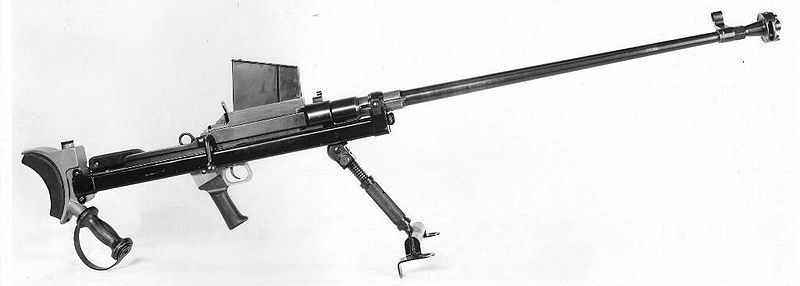
The cartridge was an adaptation of the
Browning 0.5 inch, with a belt added firing a 47.6 gram bullet.
At its introduction, the weapon was effective on light armour (16 mm thick) at 100 yards (91 m). There were two main service loads used during the Second World War, the W Mark 1 (60 g AP at 747 m/s) and the W Mark 2 ammunition (47.6 g AP projectile at 884 m/s). The W Mark 1 could penetrate approximately 16 mm of armour at 100 yards, about the thickness used on the frontal armour of a half-track or armoured car, or the side or rear armour of a light tank. Later in the conflict, a more effective round was developed, the W Mark 2, which fired a
tungsten-cored projectile at 945 m/s. The W Mark 2 was able to penetrate up to 3/4 inch (19 mm) of armour at 100 yards (~91 m), with the plate inclined at 70° from the horizontal (i.e. 20 degrees from the direct line angle of fire), the effective thickness being ~21.5 mm at 0°. Its effective range against unarmoured targets (e.g. infantry), was much further.
The weapon was popular with the Finns, because it could deal with SovietT-26 tanks which the Finnish Army encountered in many engagements...in the Pacific theatre the Boys was used against lightly-armoured Japanese tanks in Malaya as late as 1942, when the 1/14th Punjabis knocked out two light Japanese tanks at a roadblock,[3] and during the Battle of Singapore when the 1st Cambridgeshire Regiment found the Boys very useful in knocking holes through walls during street fighting. As British and Commonwealth forces lacked a longer-range rocket-propelled [high explosive shell] anti-tank weapon such as the bazooka or panzerschreck, the Boys remained in inventory for use in that theatre.
Lightweight, Small-Caliber AT Rifles?
Commander Ian Fleming's lover, Krystyna Skarbek brought to the Allies a previously top-secret Polish AT rifle, the WZ.35 that was only 20 pounds by its use of a small caliber 7.92mm bullet-but being propelled by a lot of gunpowder to achieve an extremely high muzzle velocity.

In early 1940, one of the rifles, its stock and barrel sawed off, was smuggled out of
Poland across the Tatra Mountains into Hungary for the Allies by Krystyna Skarbek and Polish fellow couriers.
http://en.wikipedia.org/wiki/Anti-tank_rifle,_model_35
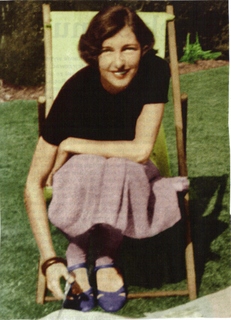
Sexy Spy Krystyna Skarbek
The rifle never saw service with the Allies, however, because the drawings and specifications had been destroyed by the Poles during the
invasion of Poland; reverse engineering would have required too much time.
Special DS 7.92mm ammunition
http://en.wikipedia.org/wiki/Krystyna_Skarbek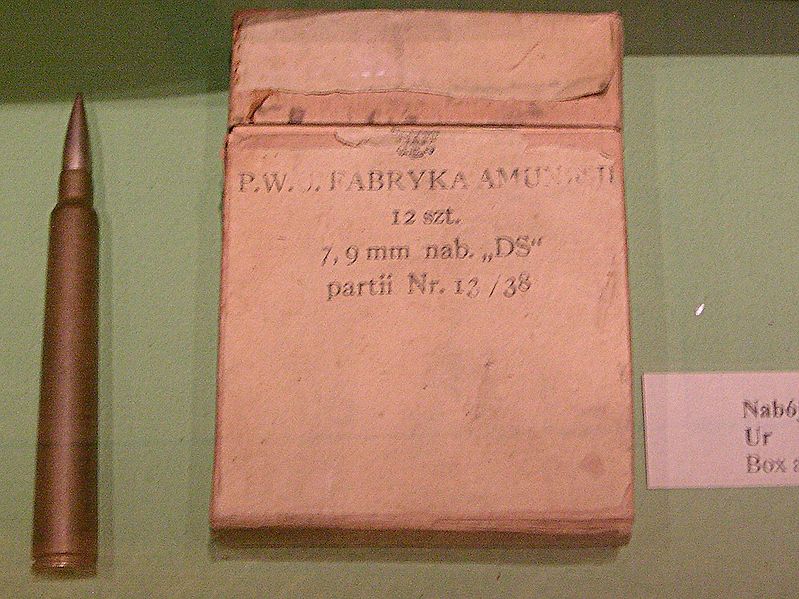
The DS ammunition was based on a standard 7.92 mm bullet as used by both the
Mauser rifle Model 1898 (wz.98) and its Polish variant the Karabinek wz.29. The length of the cartridge was extended to 131.2 mm and the overall weight was 64.25 g. After an additional series of tests the copper cartridge case was replaced with a case made of brass (67% copper/ 23% zinc).
Uniquely, compared to other armour-piercing designs, the DS round instead of using
tungsten or a similar hard metal for the core had lead, as with standard ball, but with a steel jacket. The penetration was not through punching the core through the armor but from the impact of the bullet flattening against the plate, transferring kinetic energy to the metal. The key to success for this technique was a very high bullet velocity. The result was that the bullet was punching a spall, about 20 mm in diameter, out of the armour, a size larger than the actual rifle caliber. The fragment would then ricochet inside of an armoured vehicle, possibly damaging the engine or killing the crew.
The effective range was 300 metres and the weapon was effective against all German tanks of the period (the
Panzer I, II and III, as well as the Czech-made LT-35 and LT-38) at 100 meters. At up to 400 meters it could penetrate all lightly-armored vehicles. It could penetrate 15 mm of armor, sloped at 30° at 300 m distance, or 33 mm of armor at 100 m. Interestingly, an Italian manual stated maximum penetration as 40 mm.
After the tests carried out by the Centre of Infantry Training in
Rembertów proved the effectiveness and reliability of kbk ppanc wz.35, the Ministry ordered 7610 rifles to be delivered to the Polish Army by the end of 1939. It is uncertain how many rifles were actually produced, but it is often estimated that there were more than 6,500 delivered by September 1939.
Despite well-established opinion, the Karabin przeciwpancerny wz.35 was extensively used during the
Invasion of Poland of 1939 by most Polish units. After Poland was overrun by Germany and the Soviet Union, large quantities of this weapon were captured. The Germans pressed it into service as Panzerbüchse 35 (polnisch) (PzB 35(p)), and sped up work on their own simplified, one-shot anti-tank rifle Panzerbüchse 39 (PzB 39). According to some sources, however, the Germans replaced the DS bullets in the captured ammunition with their own 7.92 mm hardened-steel-core bullets from the PzB 39.
www.specialforcesroh.com/gallery.php?action=view_image&id=9835
A friend of
Ian Fleming, Skarbek is said to have been the inspiration for Bond girls Tatiana Romanova and Vesper Lynd .
SOE operative Krystyna Skarbek
Parachuting into France to Fight the Germans
Krystyna Skarbek in RAF uniform and as a French civilian
Skarbek, as "Pauline Armand",parachuted into southeastern France on 6 July 1944 and became part of the "Jockey" network directed by a Belgian-British lapsed pacifist, Francis Cammaerts. She assisted Cammaerts by linking Italian partisans and French Maquis for joint operations against the Germans in the Alps and by inducing non-Germans, especially conscripted Poles, in the German occupation forces to defect to the Allies.
Krystyna Skarbek undercover in France in 1944
On 13 August 1944, atDigne, two days before the Allied Operation Dragoon landings in southern France, Cammaerts, Xan Fielding-another SOE agent, who had previously operated in Crete-and a French officer, Christian Sorensen, were arrested at a roadblock by the Gestapo. Skarbek, learning that they were to be executed, managed to meet with Capt. Albert Schenck, an Alsatian who acted as liaison officer between the local French prefecture and the Gestapo. She introduced herself as a niece of British General Bernard Montgomery and threatened Schenck with terrible retribution if harm came to the prisoners. She reinforced the threat with a mercenary appeal-an offer of two million francs for the men's release. Schenck in turn introduced her to a Gestapo officer, a Belgian named Max Waem.[33]
For three hours Christine argued and bargained with him and, having turned the full force of her magnetic personality on him... told him that the Allies would be arriving at any moment and that she, a British parachutist, was in constant wireless contact with the British forces. To make her point, she produced some broken... useless W/T crystals....
"If I were you," said Christine, "I should give careful thought to the proposition I have made you. As I told Capitaine Schenck, if anything should happen to my husband [as she falsely described Cammaerts] or to his friends, the reprisals would be swift and terrible, for I don't have to tell you that both you and the Capitaine have an infamous reputation among the locals."
Increasingly alarmed by the thought of what might befall him when the Allies and the Resistance decided to avenge the many murders he had committed, Waem struck the butt end of his revolver on the table and said, "If I do get them out of prison, what will you do to protect me?"
After Cammaerts and the other two men were released, Capt. Schenck was advised to leaveDigne. He did not--and was subsequently murdered by a person or persons unknown. His wife kept the bribe money and, after the war, attempted to exchange it for new francs. She was arrested but was released after the authorities investigated her story. She was able to exchange the money for only a tiny portion of its value.[35]
In that latter period of her life, she metIan Fleming, with whom she allegedly had a year-long affair,[40] although there is no proof that this affair occurred. The man who made the allegation, Donald McCormick, relied on the word of a woman named "Olga Bialoguski"; McCormick always refused to identify her, and she is not included in his list of acknowledgments.
The question has to be asked...
If the Polish WZ.35 was so effective against German and Czech light tanks, why wasn't the blitzkrieg stopped dead in its tracks by pockets of Polish infantry picking off their lead tanks?
We know that the Germans respected the Polish WZ.35 AT rifle and copied it in concept and used their AT rifles for the rest of the war. However, perhaps the truth is that exposed and static infantry cannot prevail against a blitzkrieg if its combined arms effects has high explosive artillery shells landing on them such that they cannot employ their AT weapons? As the artillery suppresses, enemy infantry can clean out the infantry with AT rifles, opening the paths for the mechanized columns to pass. This seems to be a reality and a warning that has been relived again and again with the advent of other AT weapons like bazookas and RPGs held in the hands of foot-infantry--that bodes poorly for guided versions as well like the Javelin ATGM. The warning is that infantry that refuses to combine arms--but instead wants to fight all by itself with only its hand weapons--stuck in its foot-slogging doldrums without its own light tanks is increasingly at risk of battlefield defeats and can only win against mediocre foes at great costs.
AT rifles (some of whom can shoot 20mm or 30mm high explosive shells) today pose a severe threat to lightly armored wheeled trucks like the LAV/Stryker family that cannot move except by roads/trails where they are easily ambushed. Since wheeled trucks cannot be thickly armored without even further mobility loss and mechanical break-downs; the WW2 narrative of AT rifles being unable to penetrate them does not apply. The U.S. military's units mounted in wheeled trucks are in a state of technological regression and increasingly vulnerable to both kinetic energy and high explosive (chemical energy) weaponry. The wheeled fad in the U.S. military has been a dismal failure in Iraq/Afghanistan whose continuance will result in strategic military defeats.
NTW20mm Anti-Materiel Rifle: Man-Portable, Rapid-Fire, Cannon--the End of Wheeled Trucks
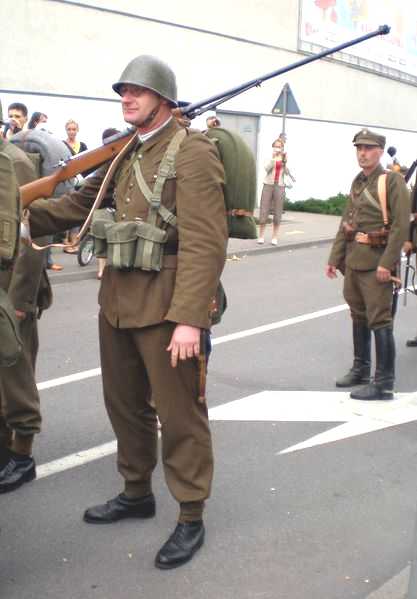
Anti-Tank Guns
 www.youtube.com/watch?v=c8xr5DE_lsQ
www.youtube.com/watch?v=c8xr5DE_lsQ
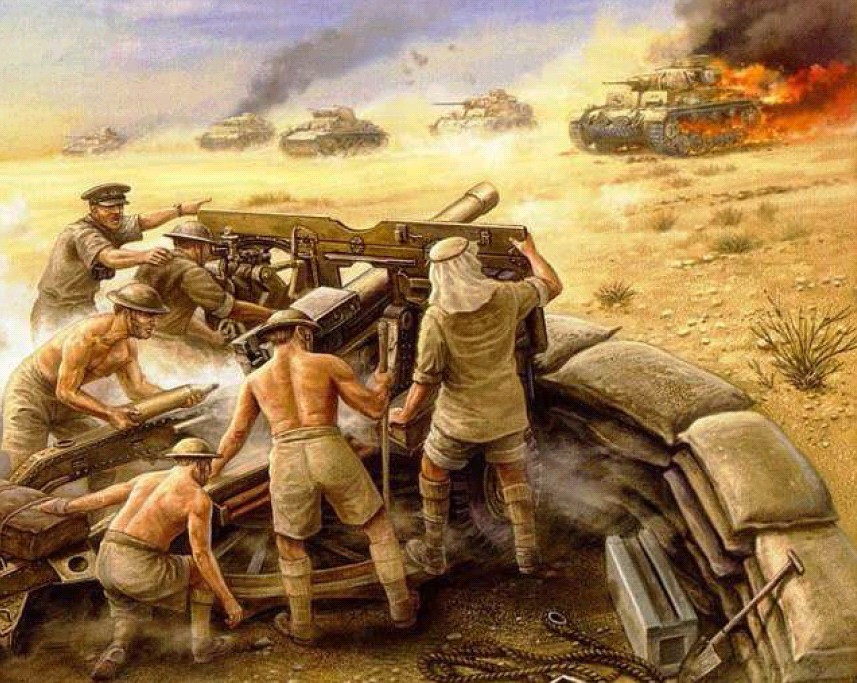
Even towed howitzers were pressed into action to stop German Tanks...
As the leading naval intelligence figure in WW2, Commander Fleming was more than aware of how Germany's tank armies had over-run the French trying to stop them with impotent 37mm anti-tank guns against their blitzkrieg tactics--since it was he who orchestrated the rescue of over 125, 000 Frenchmen and a similar number of British Expeditionary Force (BEF) Soldiers at Dunkirk using every available boat, sail boat, ship he could find. One of the reasons why Dunkirk even happened was because the British staged a desperate counter-attack at Arras into Rommel's flank using slow, infantry support Mathilda tanks which had very thick armor that the German 37mm anti-tank (AT) guns couldn't penetrate.
Unfortunately, there were no mounted, armored infantry that could follow in the trace of the Mathildas amidst exploding shells and bullets to prevent Rommel's men from depressing their towed 88mm anti-aircraft (AA) guns and knocking out the Mathildas to stop the counter-attack.
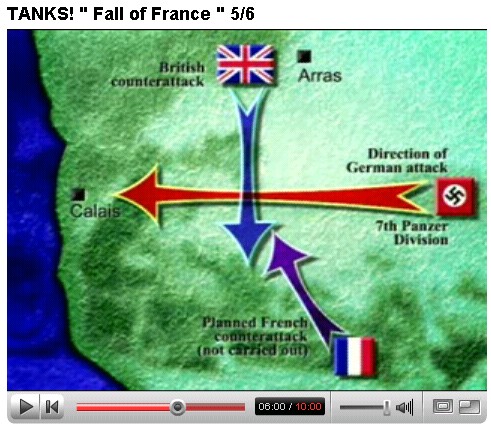
However, it was enough of an excuse to make Hitler pause and let the Allies escape to fight another day...and win the war. The legend and scourge of the German 88mm as a fierce AT as well as AA gun had begun.
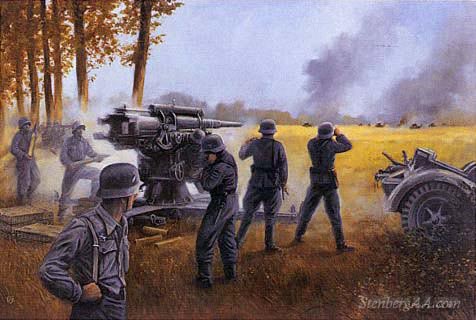
www.combatreform.org/thegermansarecomingthegermansarecoming.htm
The Allies had no counter-part until the advent of the American 90mm AA gun--that could finally depress horizontally--by the middle of the war. Development of the improved American 90mm AA gun began in 1938. The British set-back at Arras by the German 88mms took place in 1940--so why did it take the U.S. Army two years (1942) to realize its 90mm AA guns needed to fire horizontally at enemy tanks? We eventually placed this same 90mm gun in our M36 tank destroyers and the M26 Pershing heavy tank to destroy enemy tanks.
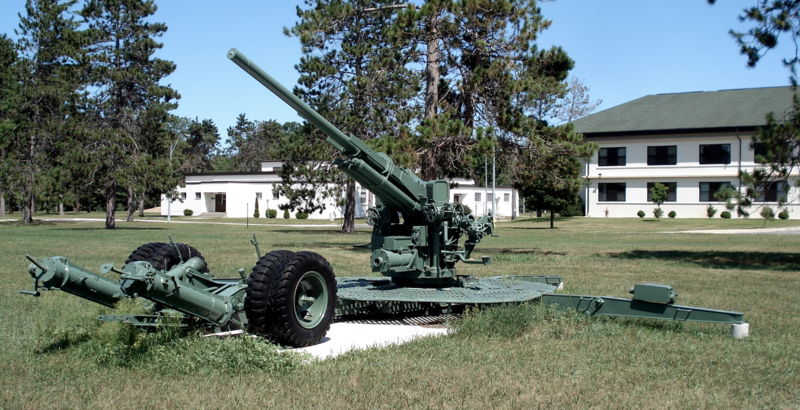
http://en.wikipedia.org/wiki/90_mm_M3_gun
Like the German 88, and the British QF 3.7 inch AA gun, the M1A1 found itself facing tanks in combat, but unlike the others it could not be depressed to fire against them. On September 11, 1942 the Army issued specifications for a new mount to allow it to be used in this role, which resulted in the 90 mm M2, introducing yet another new mount that could be depressed to 10 degrees below horizontal and featured a new electrically-assisted rammer. It became the standard weapon from May 13, 1943.
Had the Allies deployed dual-purpose AA/AT guns--even on vulnerable trucks--it might have deterred Hitler from knuckling under pressure from his generals for WW1 revenge on the French, so instead of attacking west he would have continued east to the destruction of the 3rd Reich against the mammoth Soviet Russian hordes.
www.combatreform.org/hitlerwantedtogoeastbutwewouldntlethim.htm
Tank Terror: A Tale of Ignorance in Two Directions
Studying the Allied forces "tank terror" at the hands of the German blitzkrieg one would do well to read Steven Zaloga's, U.S. Army Anti-Tank Artillery 1941-1945:
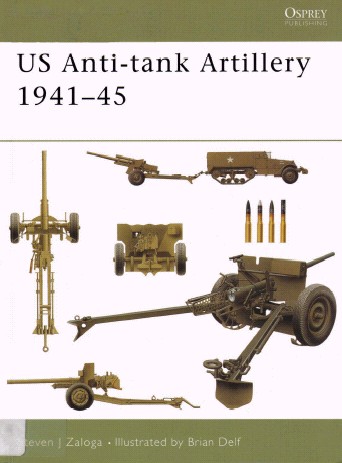
www.scribd.com/doc/3917160/Osprey-New-Vanguard-107-US-Antitank-Artillery-1941
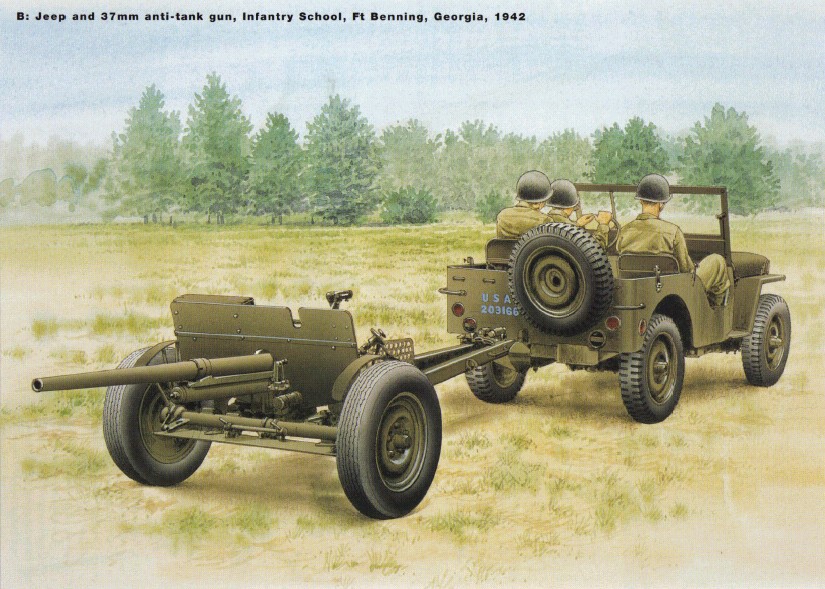
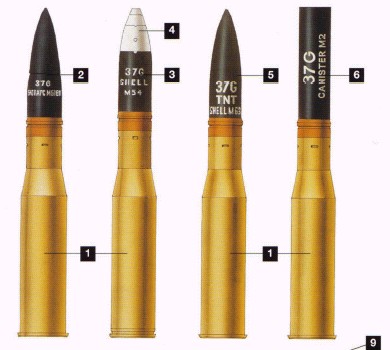
In this amazing book, he describes how the U.S. Army only adopted the puny 37mm towed AT gun after seeing the German 37mm AT's success against very light tanks in the Spanish Civil War in 1936. The Infantry branch at Fort Benning, Georgia refused to adopt a larger AT gun even though ordnance department experts warned them that future German tanks would be thicker-skinned and impervious to the 37mm.
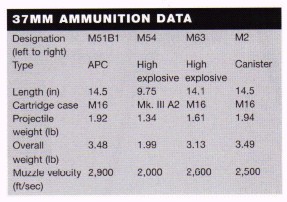
Infantry branch obsessed with dismounted, pedestrian warfare so as to subsidize their "From Here to Eternity" garrison lifestyle of petty harassment and goofing off getting drunk and chasing women after a simplistic duty day cited that the 37mm AT gun at 900+ pounds was at the limit Soldiers could tow by foot and man-handle into firing positions. This was fine for the closed terrain of the Pacific--but not enough against the rapidly improving German armor in Europe.
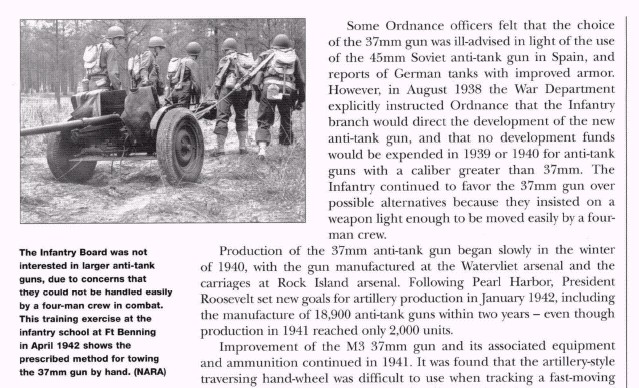
Tragically, before long, their 37mm AT guns were ineffective against heavier German tanks resulting in the defeat at the Kasserine Pass in 1943.
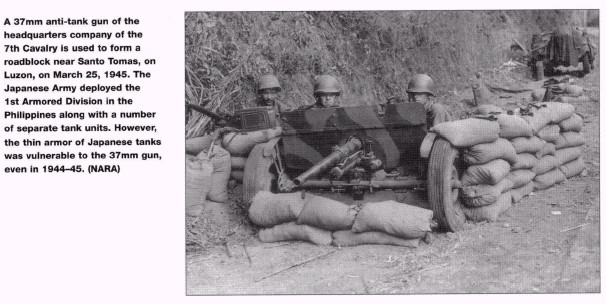
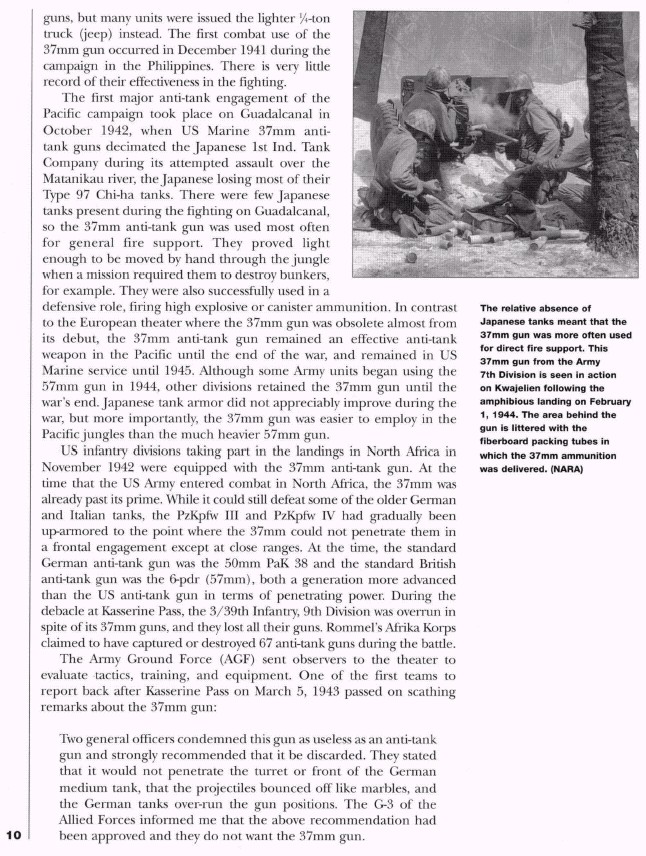
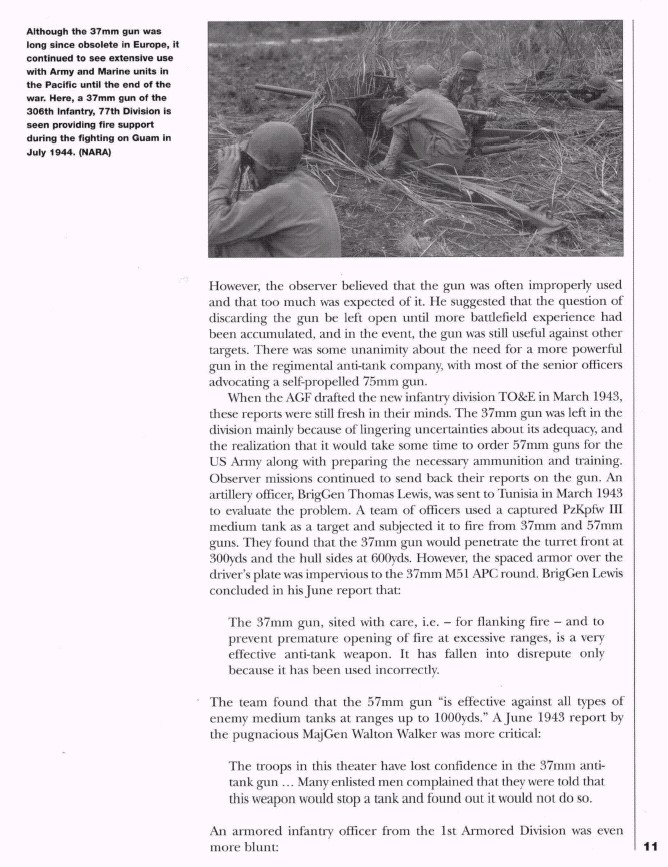
57mm towed AT guns fielded by the British were forced into U.S. service--but they were too heavy for use in the closed, vegetated terrain of the Pacific so 37mm AT guns were used there throughout the war to bust enemy dug-in positions as a field gun and to knock out the occasional Japanese light tank.
In Italy, Colonel Darby's 1st Ranger Battalion Soldiers were able to knock out thin Italian light tanks with 37mm AT guns--but not heavier German tanks. This weakness would prove fatal later at Cisterna.
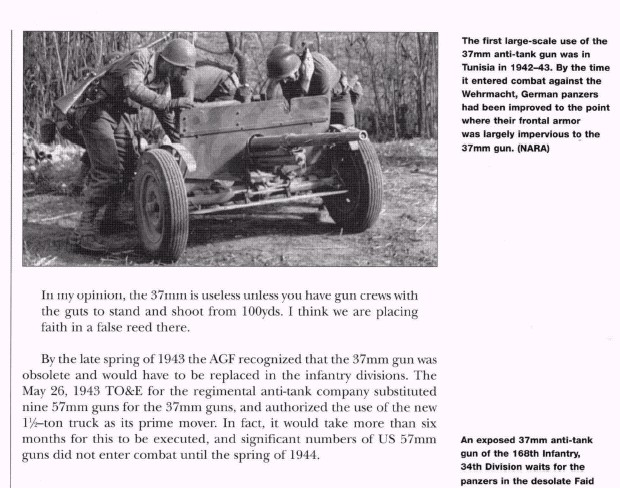
Even the 57mm AT gun was out-classed against medium Panther and heavy Tiger tanks in Europe resulting in more losses and the British fielding monstrous 76.2mm towed AT guns in lieu of the 37mm gun equipped light Tetrarch tanks that could have saved the battle for them by punching through German resistance and enabling all of the 1st British Airborne Division to concentrate and hold Arnhem bridge over the Rhine river into Germany, shortening the war.
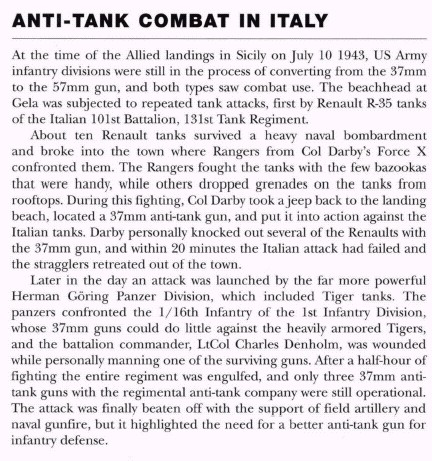
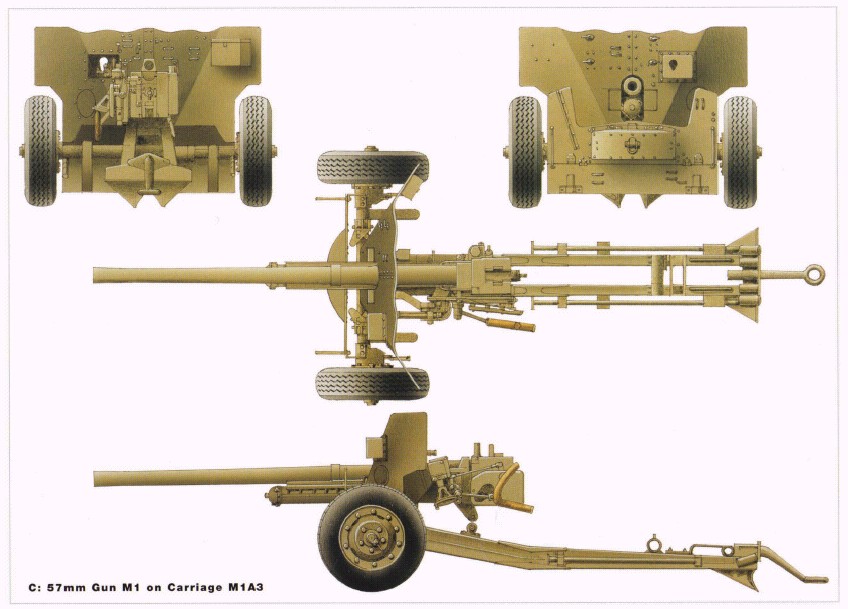
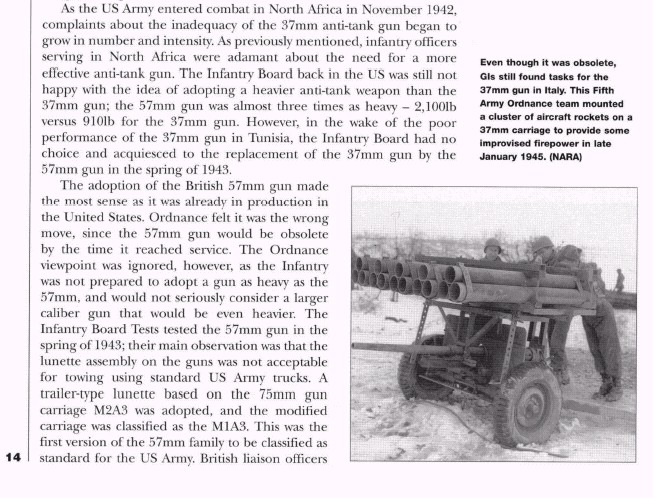
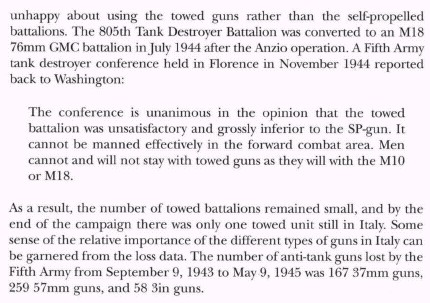
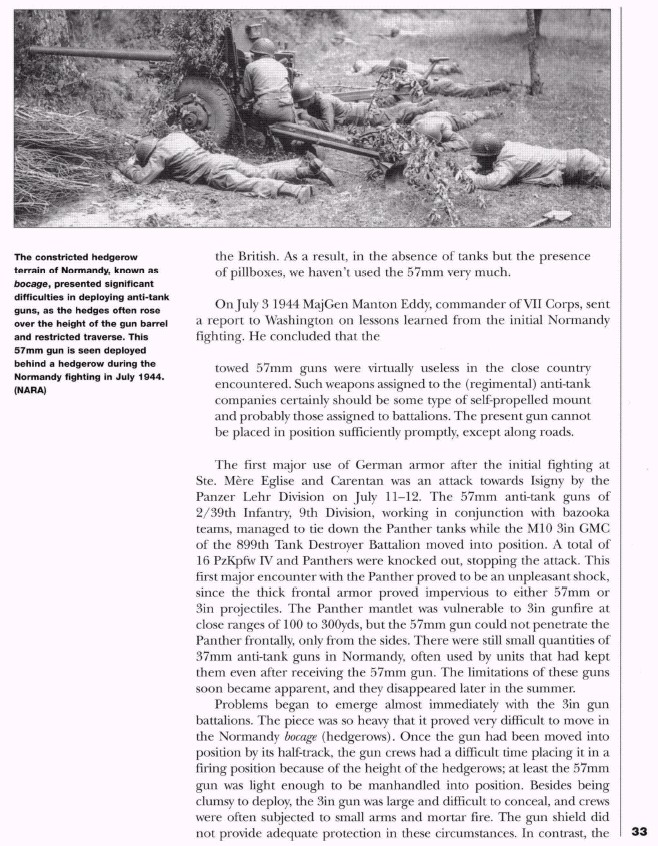
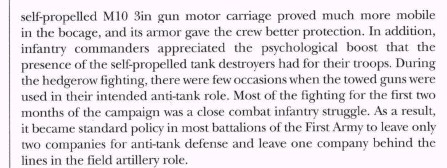
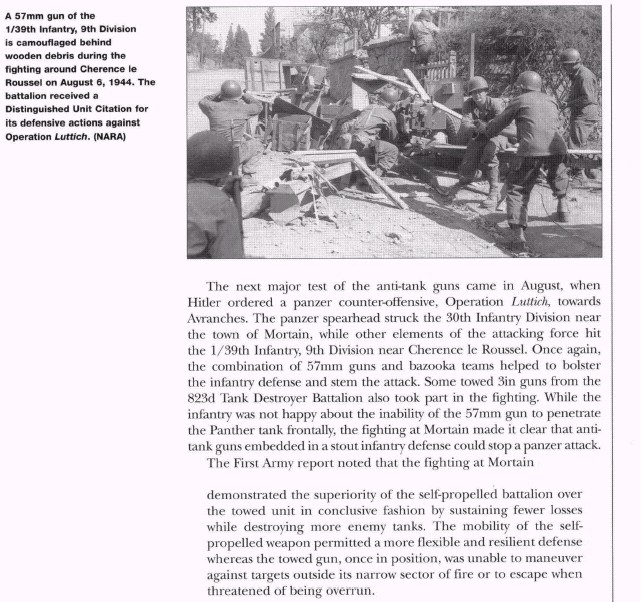
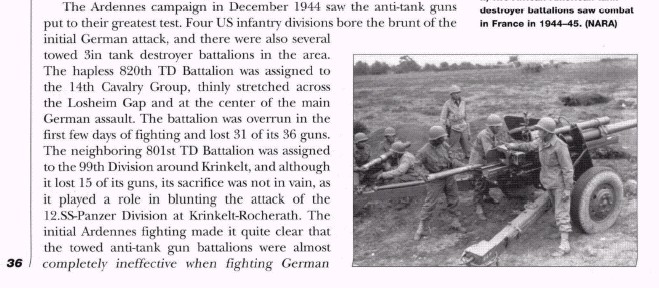
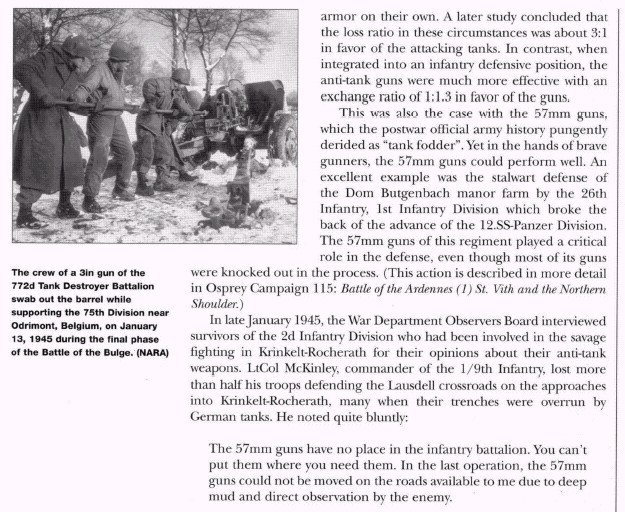
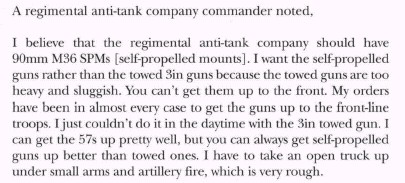
During the Battle of the Bulge, what saved American forces were the mobile, open-top turret, light M18 Hellcats, medium-weight 3-inch gun M10 "Wolverine", and 90mm gun M36 Jackson tank destroyers as the towed but then stationary 57mm AT guns and crews were decimated. It's amazing we even had SP Anti-Tank (SPAT) destroyers since artilleryman General McNair was a cheap-skate obsessed with towing and manhandling into position, weak American 76.2mm (3 inch) AT guns. At least with tracked mobility, the SPATs could position their weak American 3-inch guns to get kill shots; the static towed guns could not move quickly and only had gunshields for protection. (FYI, today's towed howitzer artillery doesn't even have gunshields!)
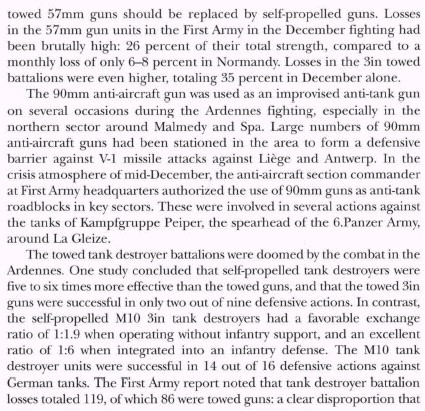
http://en.wikipedia.org/wiki/Lesley_J._McNair
He particularly came in for criticism over tank destroyer doctrine. As an artillery officer, McNair favored towed anti-tank artillery over self-propelled tank destroyers, even after it had become apparent that German forces were converting their anti-tank forces into self-propelled guns as soon as such vehicles could be produced.
The British "17-pounder" 76.2mm AT gun used far more propellant to get greater muzzle velocity and penetration power than the cheap Americans worried about barrel wear and not respecting the German tank threat.
Why the British QF 17 pounder was not installed in our M10s and M4 Sherman medium-weight tanks to defeat German tanks is an often-debated mystery in WW2 research circles. The British "Achilles" M10s and "Firefly" Sherman tanks with their QF 76.2mm guns saved the day repeatedly in WW2.
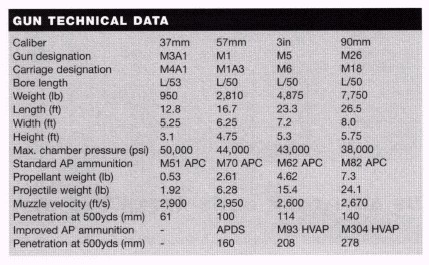
"Tank terror" was still on the minds of U.S. Army Armor officer General Don Starry whose medium Sherman tanks with low-velocity 75mm guns were outgunned and under-armored against German Panthers/Tigers resulting in him giving birth to the uber heavy 70-ton American M1 Abrams tank in the 1980s. However, the infantry at war's end drew a fatal conclusion in another direction: the towed AT gun was dead, leaving the self-propelled AT gun and the hand-held 2.36" bazooka rocket launcher as possible fixes.
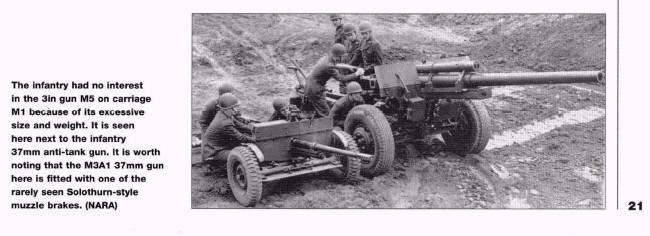
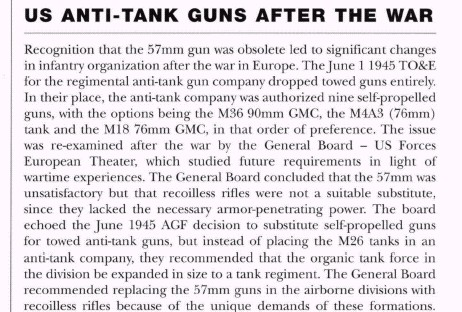
So the Army decided that anti-tank guns would be on TANKS operated by ARMOR BRANCH--separate units ATTACHED to infantry at divisional level. And what if these units do not show up to the fight? The infantry is left hanging with JUST hand-held 2.36" bazookas (tube-launched RPGs).
In other words, since infantry DOESN'T WANT TO LIGHT MECHANIZE and tried to man-handle towed AT guns and took heavy losses (it's own damn fault), it wants ARMOR BRANCH TO DO ITS JOB; when the problem is WITH THEM NOT FACING THE REALITY THAT THEY NEED LIGHT TRACKED TANK MOBILITY, PERIOD--in order to not fight wars at a WW1 foot-slog and moreover to have the mechanical advantage to STAY AHEAD OF THE THREAT with maneuverable heavy weapons in a ready-to-fire manner. The human body is limited in what it can carry; having light tracked tanks organic to the light infantry insures they have enough potential to work with to have OVERMATCH for years to come.

Notice the German infantry used light tracks for mobility without their penises falling off. We used the 
Early steel tracks were too heavy to be fully enclosed, but they were a step in the right direction. The advent of aluminum alloy armor in the LTG Gavin's M113 in 1957 solved this:
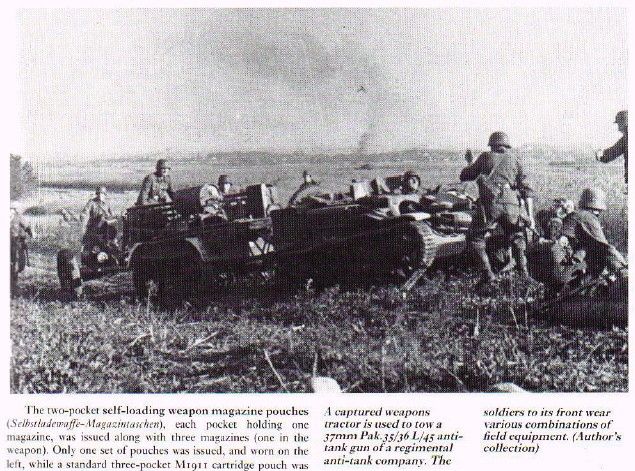
www.combatreform.org/infantrytanks.htm
M39 AUV with .50 caliber Heavy Machine Gun in Korea
However, even in WW2, we could have had a 57mm or 75mm pack howitzer or 90mm gun placed on a turret-less, well-armored armored M18 Hellcat light tank chassis (see M39 above) to be like a German STUG; but we have (and still have) a gun-size-limiting turret fixation and had to settle on a less armored, high-profile M18 Hellcat with a less powerful American 76.2mm gun in a turret.
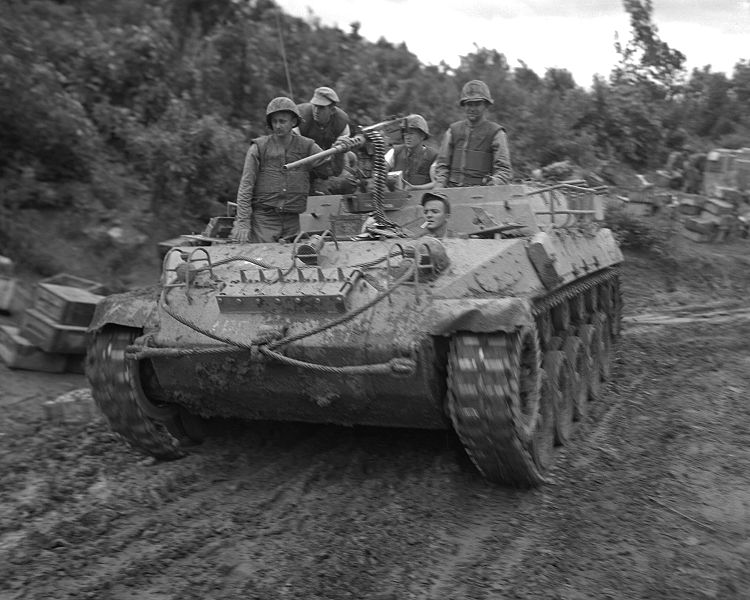
The amazing M18 Hellcat light tank would have been even better as a low-profile STUG
In contrast, an American STUG tank destroyer on the Hellcat chassis would have been a low-profile, 60 mph "hot rod"--had we wanted it. Weight saved by not having a turret would have enabled greater speeds or better armor protection. The Germans understood this, we still do not. A turret-less gun mount with 20-40 degrees side traverse is more than enough to engage moving targets once the tank's nose is pointed in the general direction. We could have built a heavy glider to deliver it for our Airborne and/or we could have mounted big guns on a lighter chassis like the Alecto. TF Smith in 1950 could have used 90mm Hellcat STUGs to knock-out North Korean T34/85 medium tanks as well as transport their infantry to avoid decisive engagement by withdrawing in good order. Why the M39 Armored Utility Vehicle (AUV) didn't have so slides/steps fitted to speed getting in and out of them is a mystery. The empty weight of a M39 AUV was 16.5 tons; still too heavy for piston-engined C-119s--but not too much had we created a heavy glider like the German Me-321 for it.
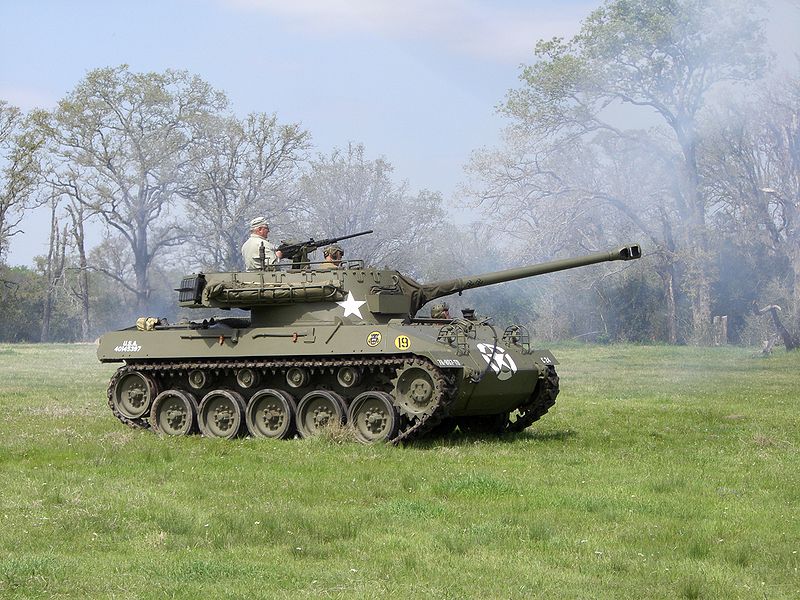
M39 AUV in Korea
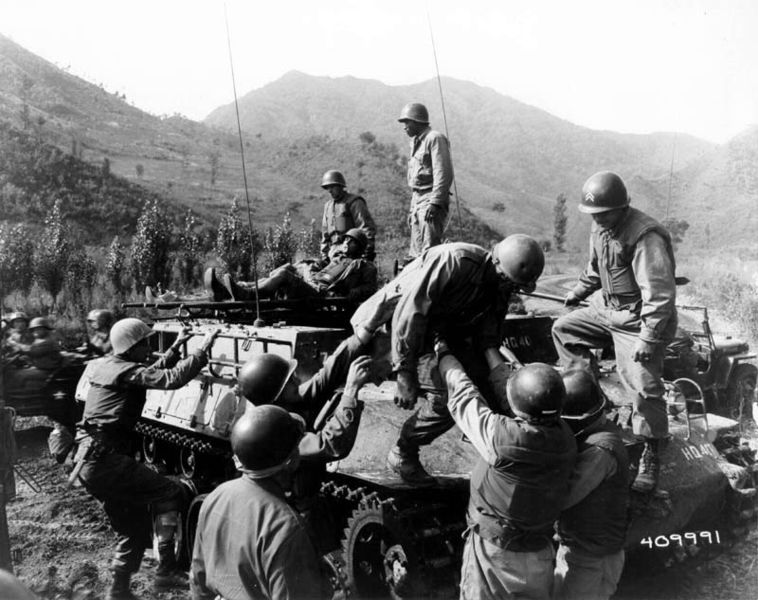
www.combatreform.org/ARMORHISTORY/index.htm
Imagine the effects on the Germans if the Molins automatic 57mm cannon used on the Mosquito Mark XIII "cannon fighter" had been placed on a light tracked chassis--not trying to tote it around by being towed.

www.combatreform.org/cannonfighter.htm
General Patton while overly optimistic about the 37mm's AT capabilities realized the critical need for a low-profile to avoid detection and get into kill shot positions--like the Germans realized early-on with their turret-less STUG light tanks, the most successful tanks of WW2.
However, U.S. Armor branch doesn't want anything unless it has a turret on it.
Even worse, Infantry branch always wanting to foot-slog DOESN'T EVEN WANT A VEHICLE; and chose instead to embrace the hand-held 2.36" bazooka setting the stage for the Task Force Smith debacle in 1950 when North Koreans with Russian T34/85mm medium tanks over-ran them when their rockets couldn't even dent their frontal armor at suicidal close range. General Gavin had already realized bazooka men had to fire their weapons at close range and awarded them a special patch to honor them and called for longer-ranged recoilless rifle AT weapons on light tanks in his book Airborne Warfare in 1947, but his warnings were ignored and the Korean War tragedy had to occur before we made some proper adaptations:
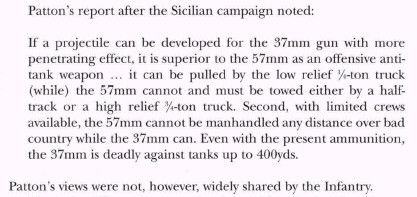
www.combatreform.org/airbornewarfare.htm
American Infantry's Fundamental Misunderstanding of the Pattern of War
American infantry based at Fort Benning, Georgia is fundamentally incompetent at perceiving the pattern of war due to bureaucracy and excessive pedestrian, narcissistic hubris. British General Francis Tuker warned us in 1945 that the pattern of war must be perceived with professional, scientific objectivity and that pedestrian forces must have maneuver mobility--or else they will be pinned down by enemy fires or worse ignored as they are bypassed and left to starve:
www.combatreform.org/thepatternofwar.htm
The first misunderstanding is that there are TWO TYPES of TERRAIN on Planet earth; OPEN and CLOSED.
This is the Battle Against the Earth (TBATE):
www.combatreform.org/TRANSFORMATIONUNDERFIRE/index.htm
To try to make one infantry that can be optimized to fight in both closed terrain East Asian tropical jungles and open terrain European plains and forests is impossible; hence the anti-tank bias of the Army forces in the Pacific occupying Japan that was not ready to stop the North Koreans in T34/85 medium tanks on the plains and hills of South Korea in 1950--even though they had M24 Chaffee light tanks with 75mm guns OWNED AND OPERATED BY A SEPERATE ARMOR UNIT that could have been air or sea delivered to them. These tankers and light tanks went "AWOL" (excuse was their guns lacked oil for their recoil mechanisms) and TF Smith was over-run by the Communists.
www.combatreform.org/ARMORHISTORY/index.htm
However, Type A personality light, narcissistic infantry (LINNIEs) doesn't want to light mechanize (have its own light tracked tank mobility, armor protection and firepower) due to snobby emotionalism to not look like heavy units they despise and consequently is constantly being creamed on foot when its hand weapons are found wanting in The Battle Against Man (TBAM) struggle to have a weapons superiority advantage. It's a pattern of failure that keeps on repeating:
Kasserine Pass: 1943
Cisterna: 1943
TF Smith: 1950
Beirut: 1983
TF Ranger Mogadishu: 1993
Its repeating today daily in Afghanistan and Iraq (2010) where light infantry not wanting to be seen in the tracks the heavy unit "mech pussies" use--gets creamed on roads/trails where high explosive land mines and RPGs await.
The Bazooka Mentality as a "Cure-All"...That doesn't Work
When the Army insisted on foot-slogging and manhandling AT guns in WW2 and took horrendous casualties instead of getting mechanical advantage via light tracked tanks to self-propel AT/Assault guns to get the job done (like the Germans did with their turretless STUGs) they instead default back to the hand-held bazooka.with battle-losing consequences in just 5 short years afterwards.
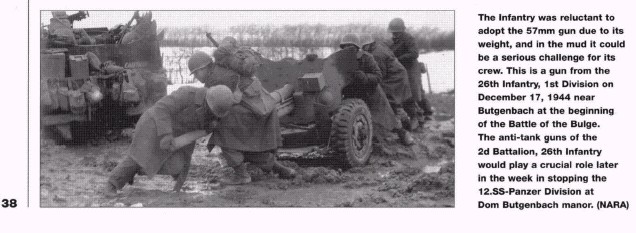
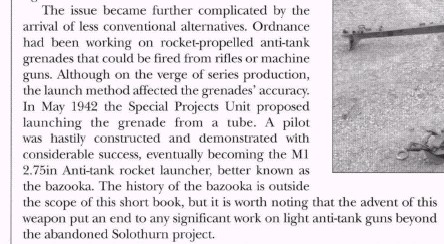
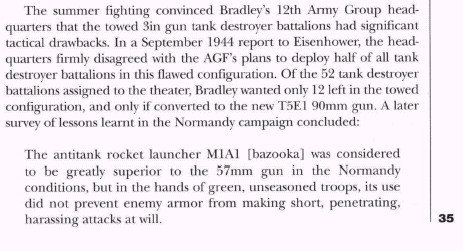
You can see the absurd fall-out from TF Smith by visiting the National Infantry Museum adjacent to Fort Benning where the conclusion being put out to the gullible public is that the 2.36" bazooka was solely at fault--not the whole pedestrian light infantry force structure which doesn't have TBATE or TBAM overmatch through light mechanization---and was somehow solved afterwards by fielding monstrous 3.5" bazookas. When foot-slogging fails, the "solution" is you guessed it--always more foot-slogging!!!!!!--until of course, its found wanting in the next Beirut of Mogadishu--where another false pedestrian remedy is then applied.
American light infantry refuses to accept the fact there is a HUMAN LIMIT to the amount of equipment a man can carry:
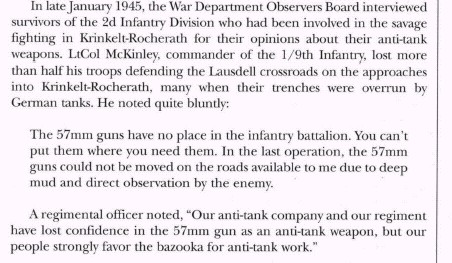
www.combatreform.org/combatlight.htm
...and that limiting our options to only what is man-portable results in force structure mistakes like the 37mm AT gun before the war or the 2.36" bazooka after the war--which means at best, our latest hand-weapon weapon will only have a TEMPORARY ADVANTAGE over future enemies--who will have more potential to work with since they have no egotistical hang-ups about using MECHANICAL ADVANTAGE in the form of vehicles to get it. Absurdly, today, we don't even have reusable bazookas in our main force infantry units to offer HE bunker-blasting firepower like the enemy does with his plentiful RPG launchers:
The reason is the LINNIEs are Kinetic Energy (KE) bullet gunslingers and resent HE weaponry--even if its delivered by an infantryman on foot! Disposable AT/Assault rockets like the M136 84mm "AT4" are not re-usable weapons factored into our tactics and drilled so we have gunners with skilled accuracy using them. A few Army Rangers have the superb 84mm Carl Gustav recoilless rifle and the USMC the 83mm Mk153 SMAW rocket launcher--but these are in small numbers, as our main force infantry's ranks lack HE punch.
www.combatreform.org/carlgustav.htm
The infantry platoon has a 50-pound fire & forget $78, 000 each Javelin Anti-Tank Guided Missile (ATGM) operated by 2 men with a 2 kilometer range to handle "tank terror"--but is too expensive to routinely blast bad guys in the increasingly urbanized battlefield. The infantry so far refuses to even use bikes or carts to transport heavy Javelin missiles and their Command Launch Units (CLUs).
www.combatreform.org/popguns.htm
What's going to happen if the enemy combines his arms skillfully and drops artillery and mortar fire on our Javelin ATGM gunners? Or lays a smokescreen that blinds them?
www.combatreform.org/smokescreen.htm
Well, they are not going to be stopping enemy tanks; who may bypass or run right over them just as LTG Tuker warned us happens. Making excuses like "our Air Force will get them" or "our Combat Engineers will block them with mines/obstacles" is unprofessional, irresponsible, pass-the-buck, bullshit and the LINNIE knows it the minute it leaves his lips. Relying on the other guy to do your job has been proven fatal in battle-after-battle; its high time the American infantry stop ignoring its weaknesses with bureaucratic excuses and instead unfucks itself (that's right, I cursed--it's fitting here in light of all the men who have died and been maimed needlessly) with professional, light mechanization.
Today, we are so weak in HE punch, even in Sub-National Conflicts (SNCs) fighter-bomber air strikes have to be called in as soon as a bad guy ducks behind a thick Afghan mud wall or concrete Iraqi building--resulting in needless civilian casualties and making more rebels who hate us:
www.combatreform.org/johnpaulvann.htm
Ousted Afghanistan Theater commander, General Stanley McCrystal realized killing civilians only makes more rebels and put a curb on air strikes, but DID NOTHING TO FIX THE INHERENT VULNERABILITY OF PEDESTRIAN INFANTRY SO IT CAN SHRUG OFF ENEMY FIRES AND STRIKE BACK AT ONLY THOSE WHO DID IT. The reason of course, is that General McCrystal is a LINNIE. I like his leadership-by-example ethos but his pedestrian LINNIE technotactics stink. To his credit, while Commander of the 75th Ranger Regiment, then Colonel McCrystal favored buying Wiesel 2 light tracked tankettes to transport his Rangers, but the manufacturer was so cheap they refused to spend the $4K to put one in a shipping container and enable them to test-drive it. Would you buy a car sight un-seen without at least a hands-on?
www.rollingstone.com/politics/news/17390/119236
His CONcept of OPerations (CONOPS) of guarding ink blots of Afghan villages and cities will not work as long as the AFPAK border is not secured by a sensor/security fence back by artillery dialed-in to strike at intruders and Quick Reaction Forces positioned in fortified Forward Operating Bases (FOBs) ready to clean up any "leakers".
www.defensereview.com/the-afghanistan-long-term-security-solution-afpak-border-security-fence-not-more-us-troops/
What is the Way Forward?
LTG Gavin realized in the 1950s that the solution was to place infantry in light tracked tanks with basic KE bullet and HE fragment protection that were fully cross-country and amphibious mobile: his M113 "armored personnel carrier". In Vietnam and ever since, the M113 Gavin has been empowering infantry to win fights all over the world. Other countries have adapted their Gavins to have the required AT/Assault guns and missiles to create the SPAT capability we realized we needed at the end of WW2.
www.combatreform.org/m113combat.htm
Thus, we have the solution in-hand to give light infantry the cross-country, armored mobility it needs with a simple-to-maintain and operate vehicle that can be made land-mine and RPG resistant with v-hull shaping and advanced applique armor technology. However, due to hubris, a fatal mistake was made to equip light infantry with the fatally-flawed Humvee wheeled truck in the early 1980s--which lacks in everything--and has been a repeated failure in battle--which this author warned everyone about in 1989 to no avail:
 www.youtube.com/watch?v=_sOEkhvntOk
www.youtube.com/watch?v=_sOEkhvntOk
www.combatreform.org/hmmwv.htm
The towed gun is not in a ready-to-fire position and takes critical time to get it into action. If you are under enemy fire you may simply be unable to get it into action. This was fatal to Operation MARKET-GARDEN where a mere pair of German armored cars with guns ready-to-fire stopped the British foot-infantry from reaching Arnhem bridge to consolidate with LTC Frost's men who were already there. The British Paras had towed 20mm Polsten AA guns but couldn't bring them to bear on the Germans. Look how long it takes to get a German towed 37mm AT into action--and how exposed there are!
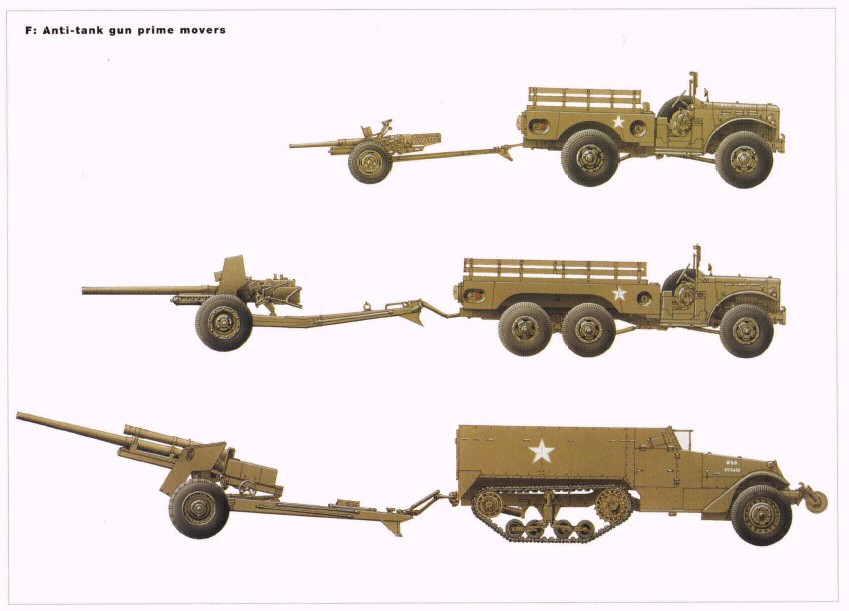
www.combatreform.org/airbornewarfare.htm
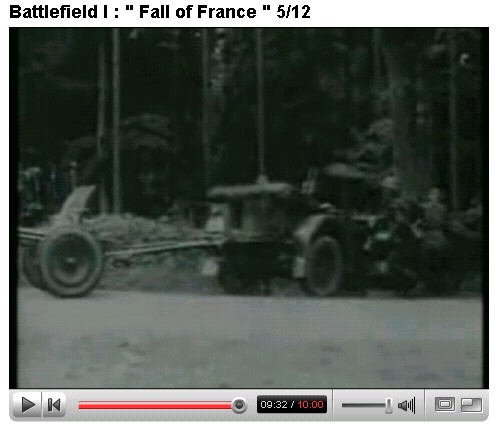
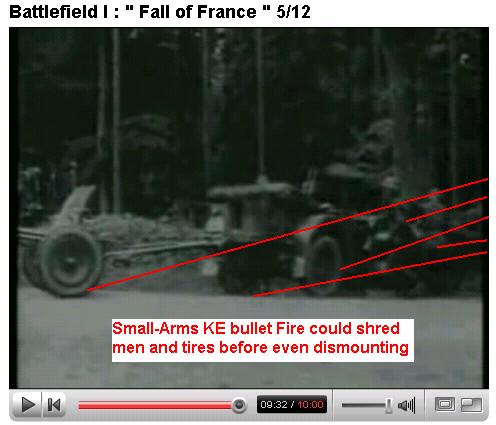
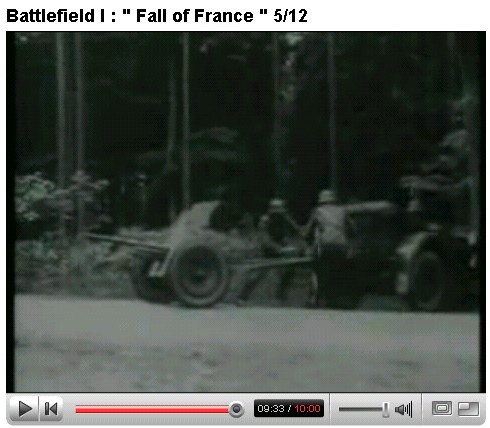
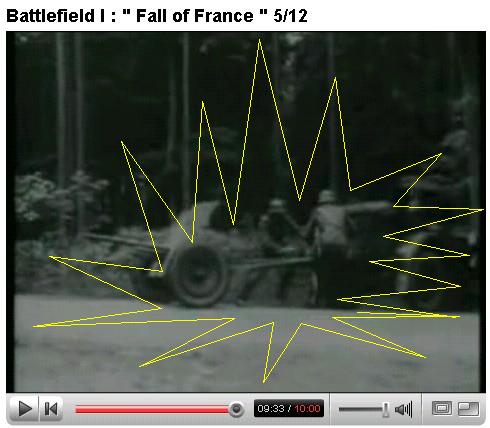
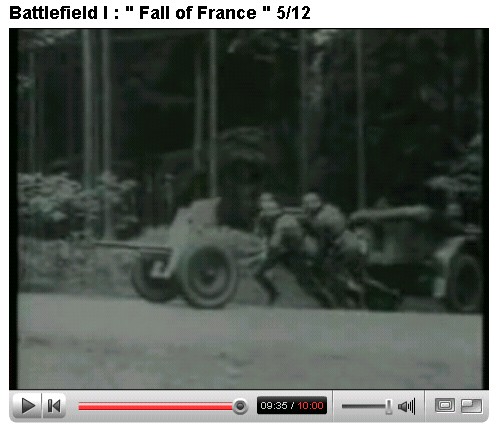
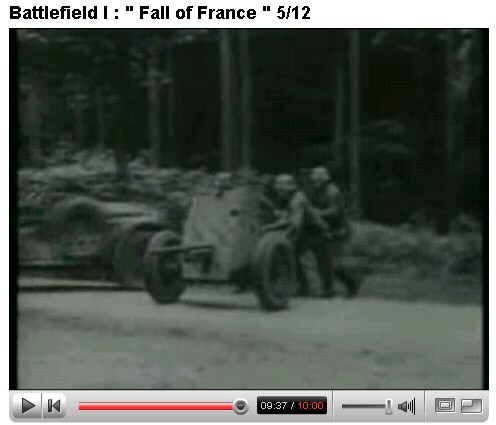
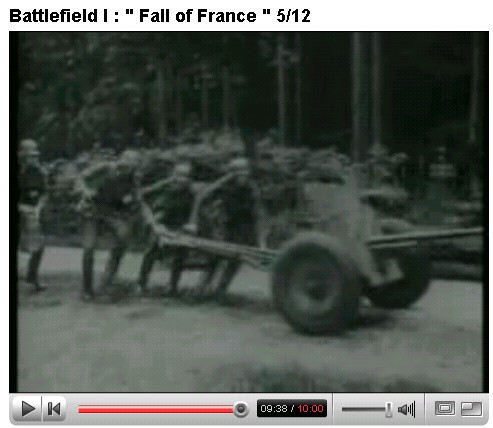
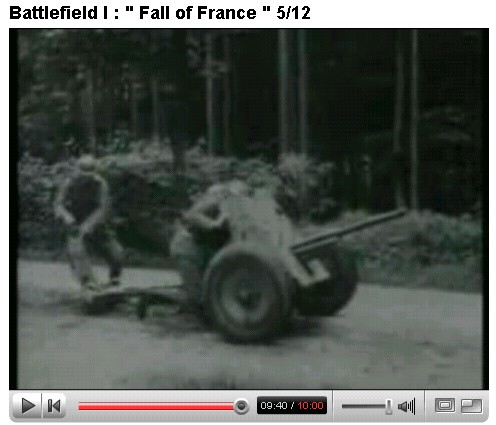
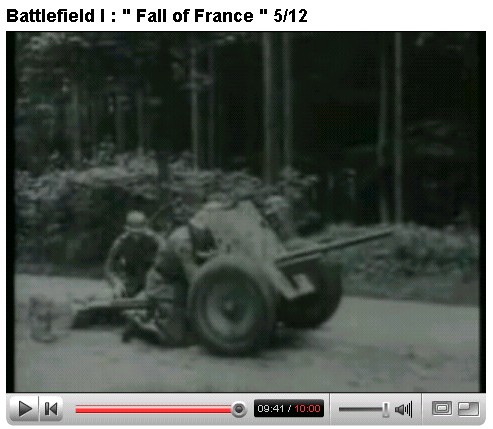
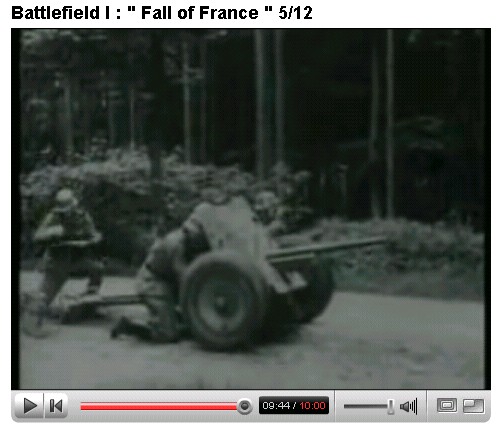
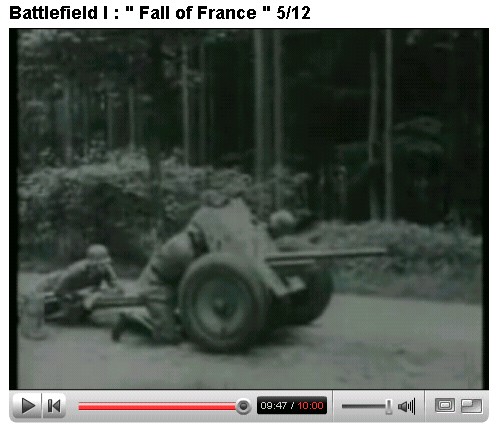
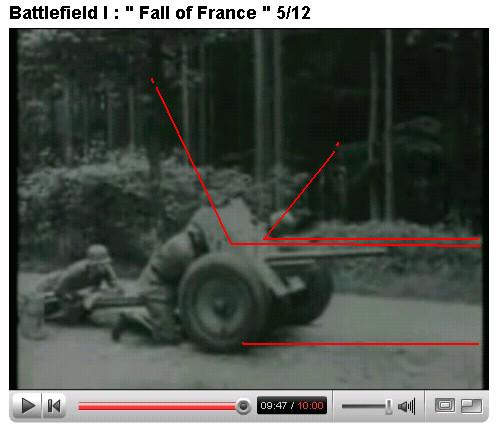
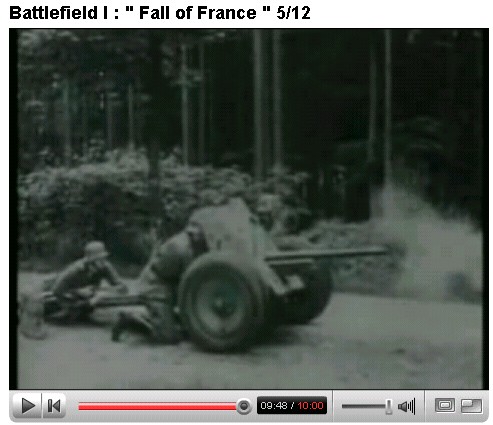
Battle lost.
War prolonged by 1 year.
Communist Soviet Army reaches Berlin first, placing Eastern Europe under their brutal domination for 45 years.
So do not, tell me these technotactical details are not important.
The Bazooka Mentality Blows-Up-In-Our Face (Again) in Korea, Vietnam and Lebanon
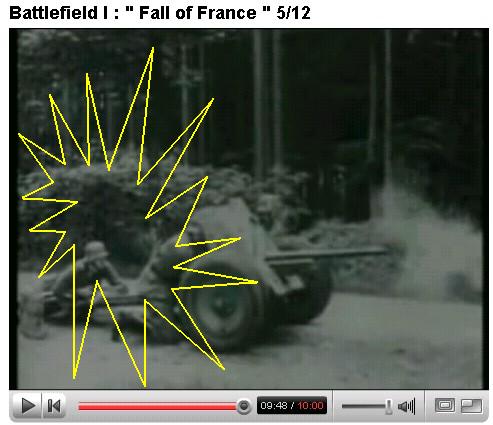
If you think trying to blast enemies from behind
In the aftermath of WW2 when we knew the bazooka mentality was fatally flawed, the lame-brained U.S. infantry branch foisted the job of destroying enemy tanks upon ARMOR branch via SEPARATE units attached that of course, in a pinch would fail to show up for duty as the M24 Chaffee light tanks were uninvited and AWOL from Task Force Smith in South Korea in 1950. If you think it was lunacy to try to stop enemy tanks with towed 37mm AT guns before WW2, trying to do it only with only 2.36" bazookas is even more stupid and TF Smith was over-ran by North Korean T34/85 medium tanks. Take a trip to the National Infantry Museum at Fort Benning, Georgia and the liars try to con you all would have been well had they been equipped with 3" bazookas. To the light infantry narcissist, the solution is always more foot-slogging. Nevermind how 3" bazookas are not going to protect you from enemy fire and provide cross-country mobility to fall back in good order. THE
We do not even do the "bazooka" thing well--our
The Guided Bazooka: ATGM Panacea that Hasn't Panned Out
So without events like WW2, Korea and Vietnam to remind us infantry needs armored mobility and firepower, our infantry has gotten weaker and weaker
Light infantry narcissists don't understand that they need light tanks not just to fight other tanks; that they provide FOR THE JOB THEY ARE TO DO critically important protected mobility and heavy weapons and supply conveyance. Even the IDF has fallen to light infantry narcissism by their dismal WW1-style foot-slogging into Lebanon in 2006, where they were so pinned down by Hezbo ATGM gunners they had to hide is houses by day. The Hezbos caught wind of this and started to launch their ATGMs into these buildings where the IDF infantry was clusterfucked causing heavy casualties. All because they refused to face the challenge of Precision Guided Munitions (PGMs)--which is what an ATGM is, and to DEFEAT them--not stick-your-head-in-the-ground and revert back to WW1 foot slogging and become
The Absurd Foot-Slogging Continues!
Yet, in the early 1980s, when the heavy units made the mistake of the bloated Bradley, American light infantry should have embraced the thousands of M113 Gavin light tracks made available to light mechanize themselves into a kick-ass force with all-terrain platforms with plenty of payload potential to work with to keep on adapting new weaponry to fight the enemy from OVERMATCH--M113 Gavin + "M16" + Cannon + Rockets + Mortars + Missiles versus "AK-47" & RPG of the enemy.
Instead of LEARNING from what non-linear Vietnam showed us, they opted for the absurd and fatally unsat Humvee truck; which the author warned everyone was going to cost us lives and limbs YEARS BEFORE THE IRAQ AND AFGHAN DEBACLES:
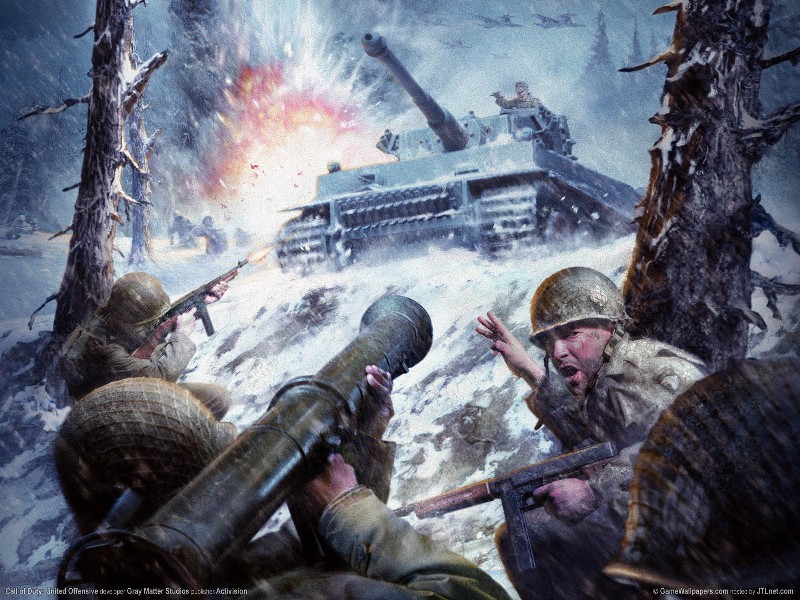
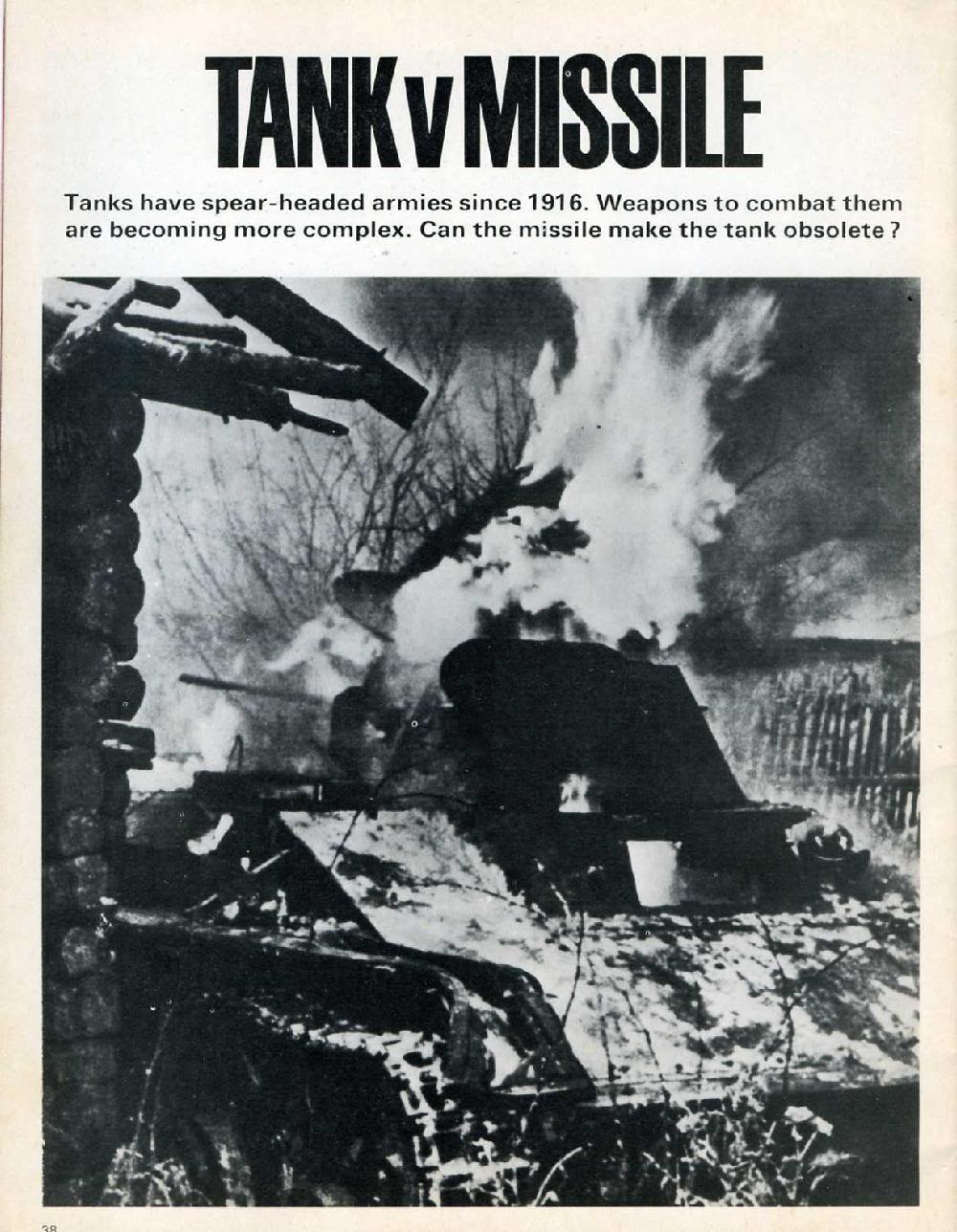
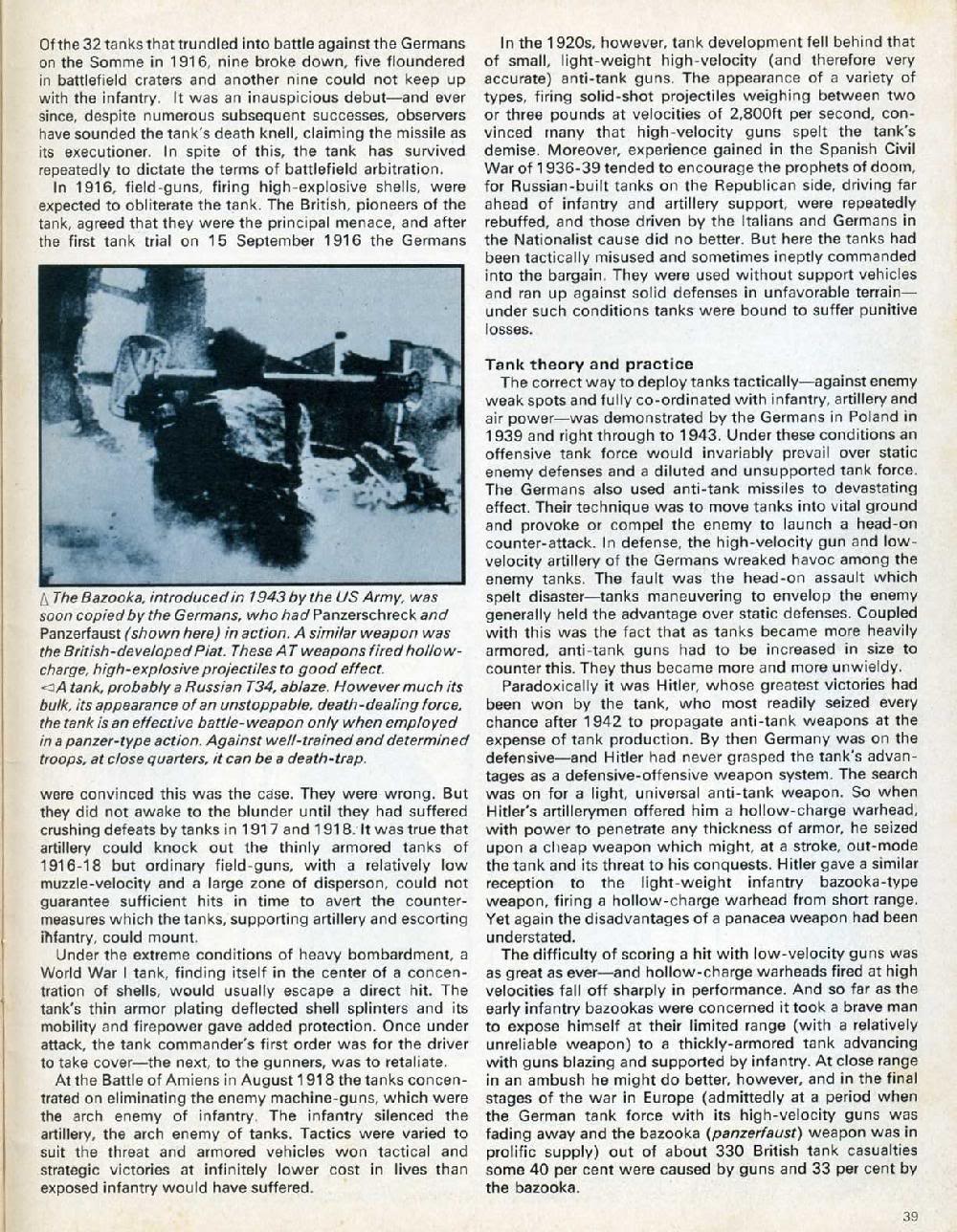
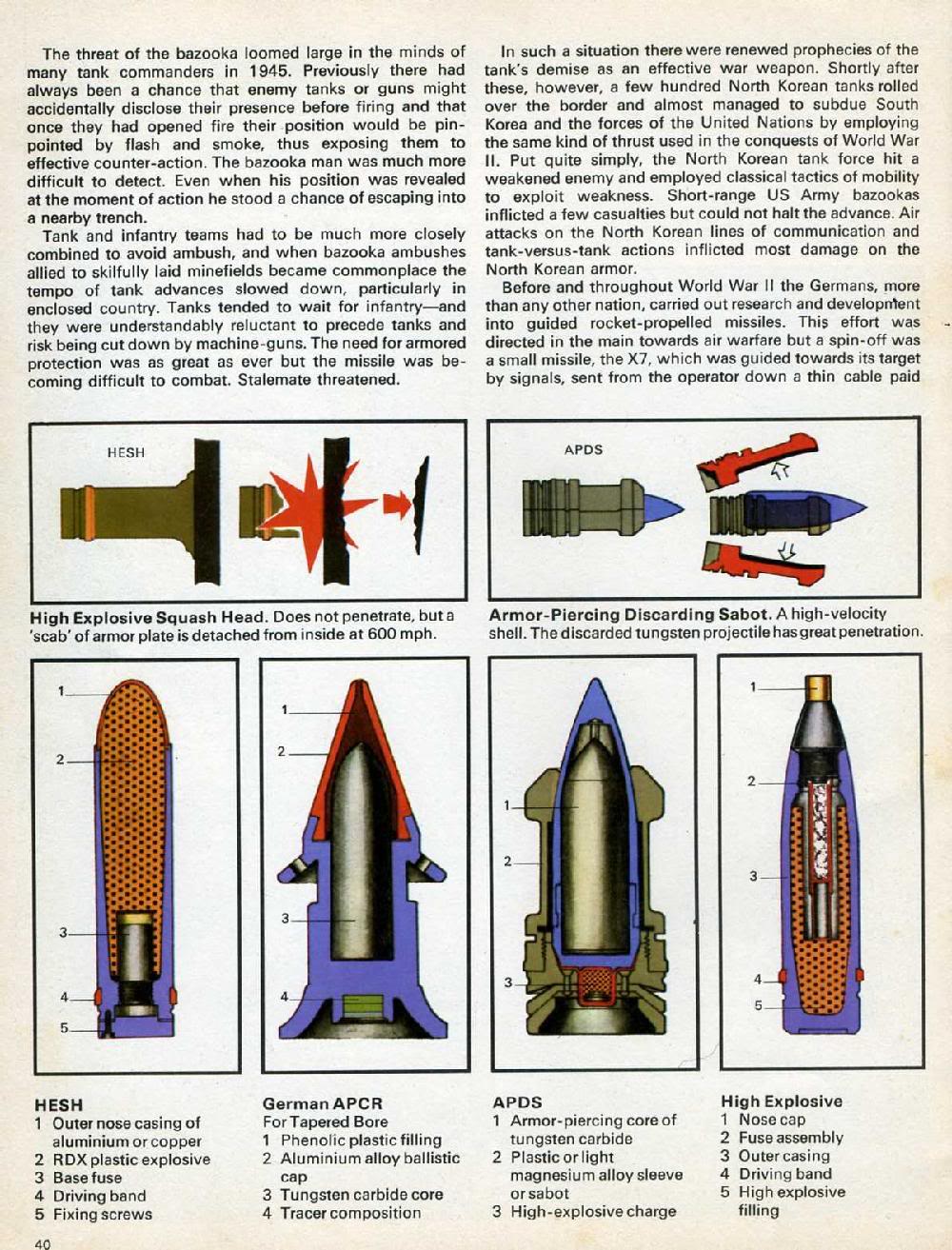
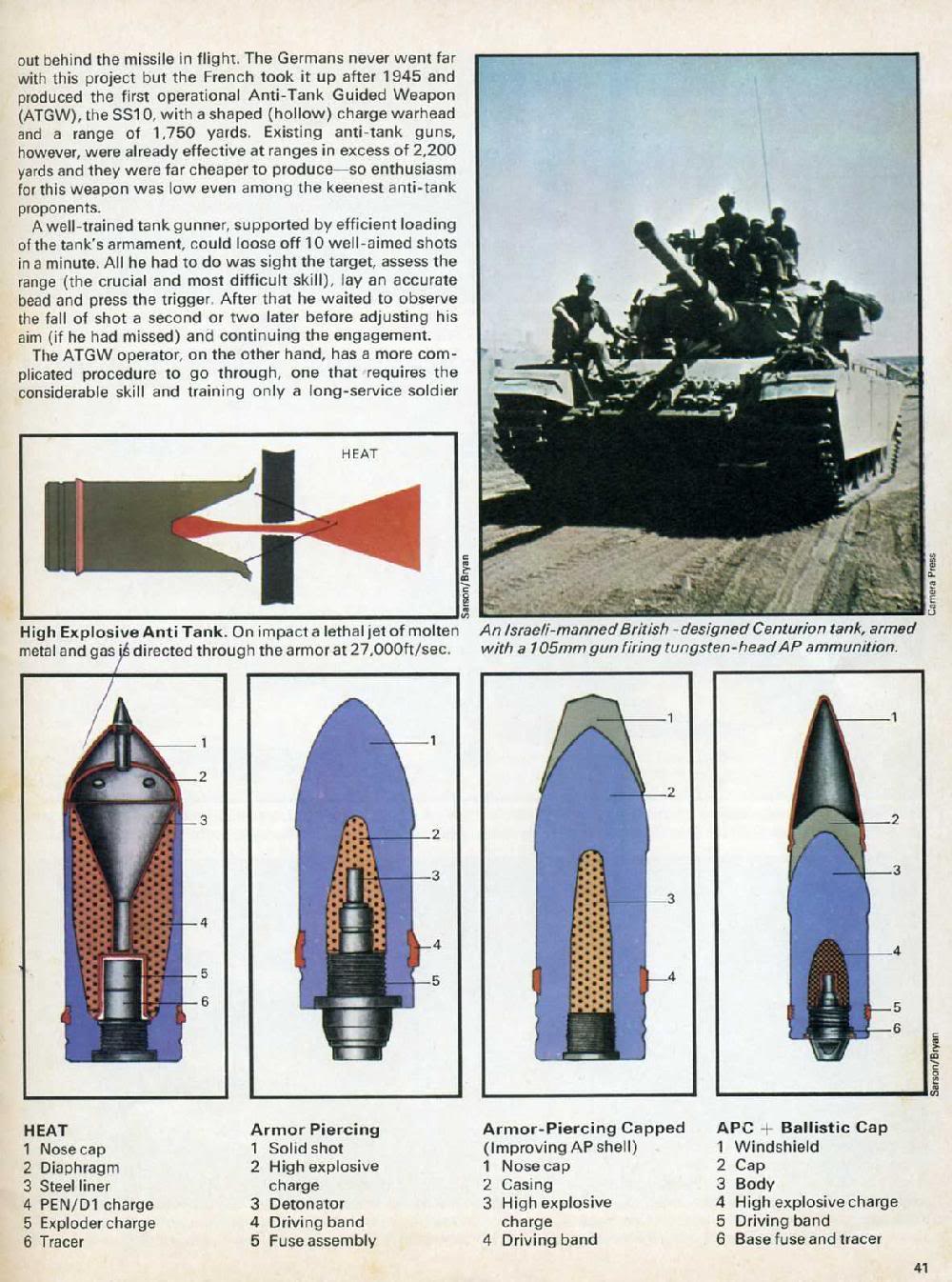
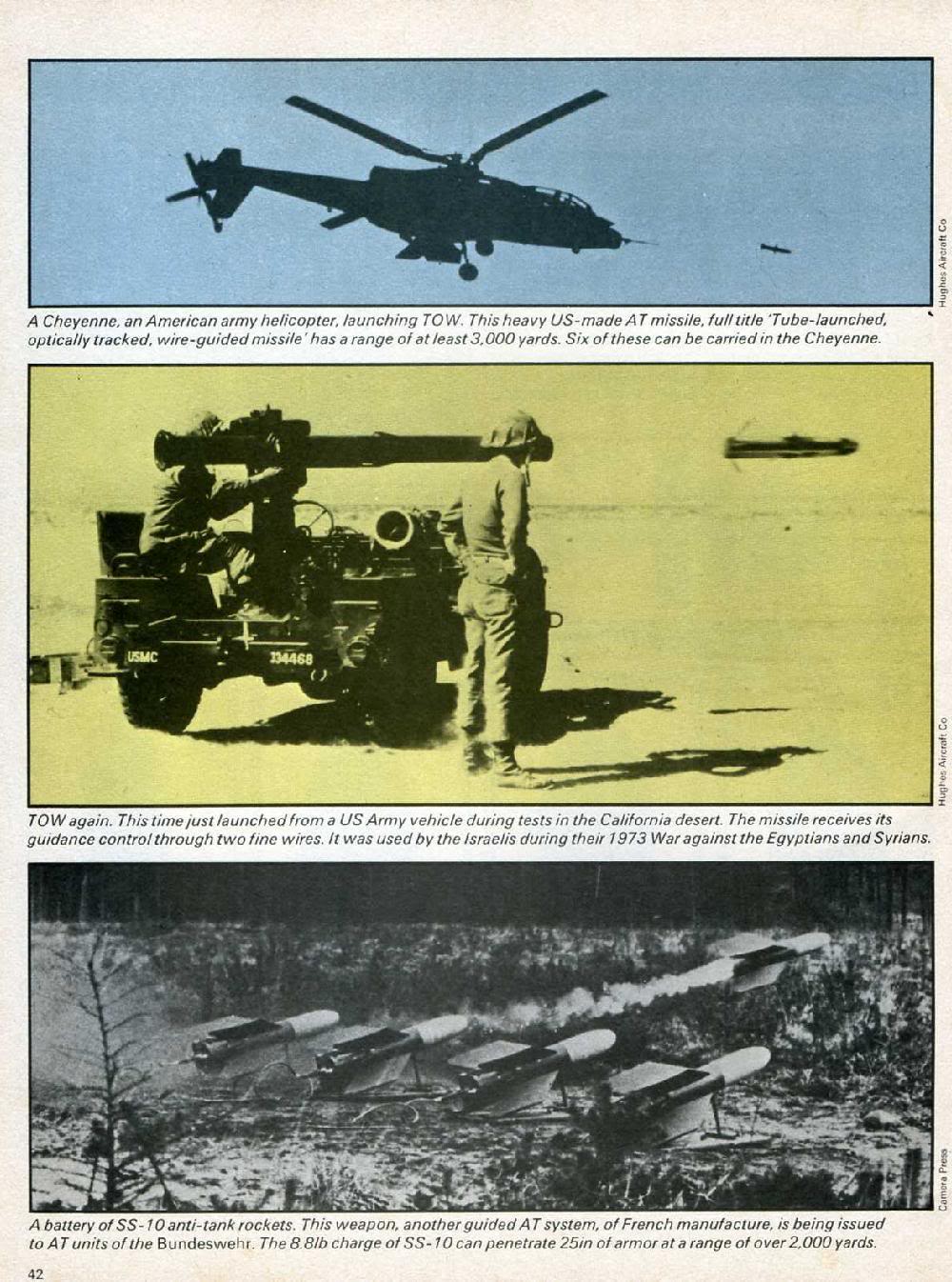
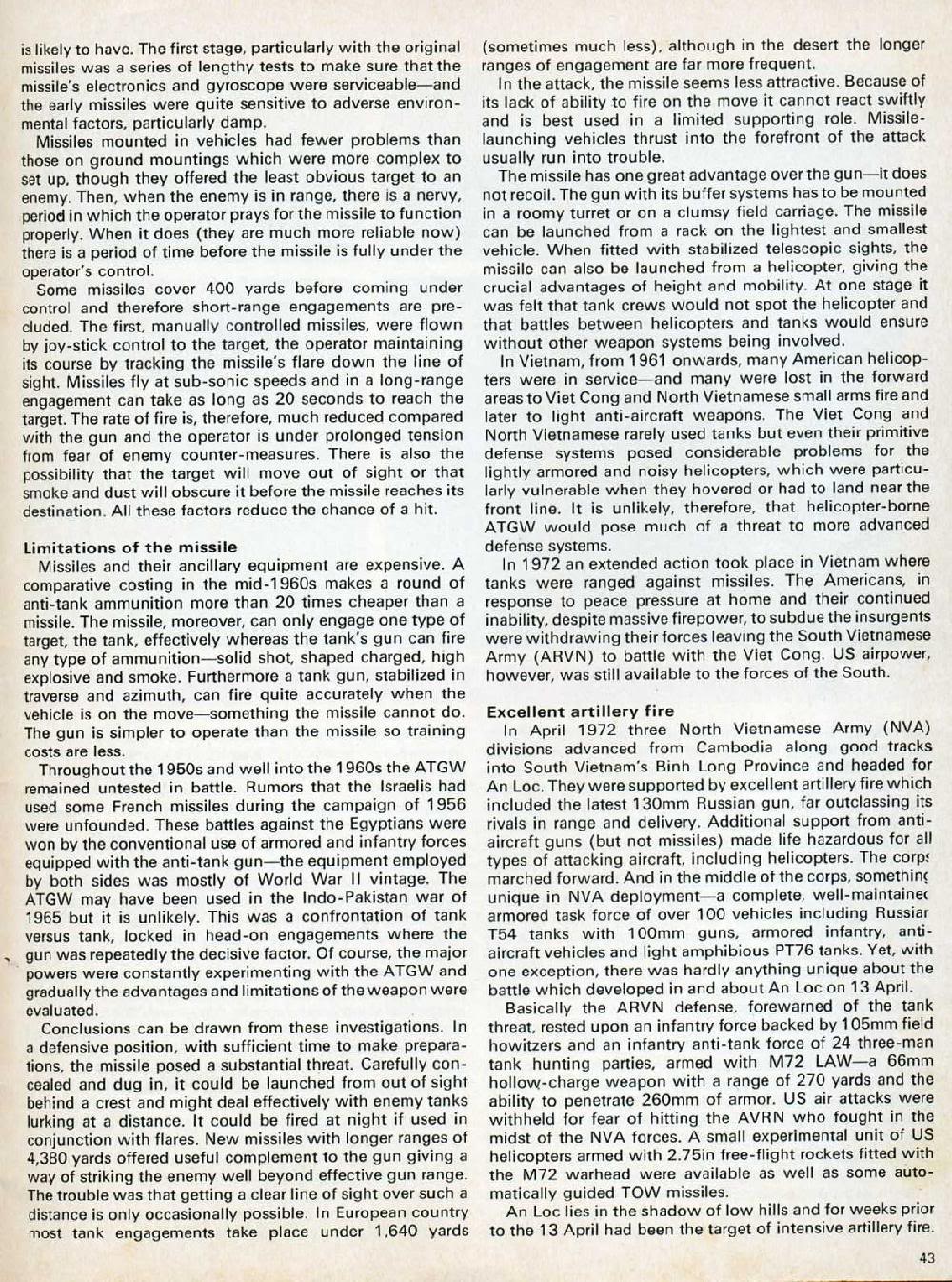
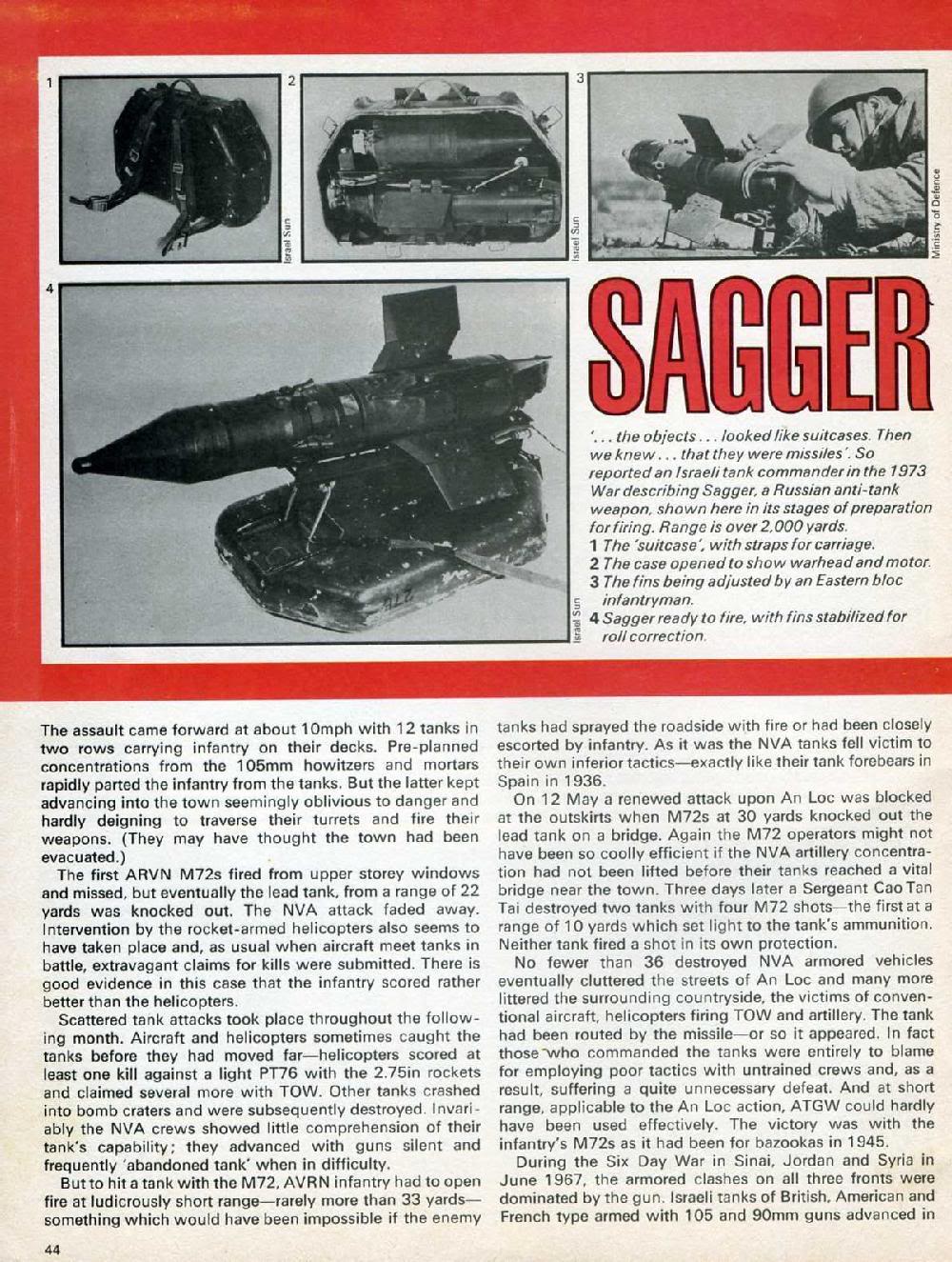
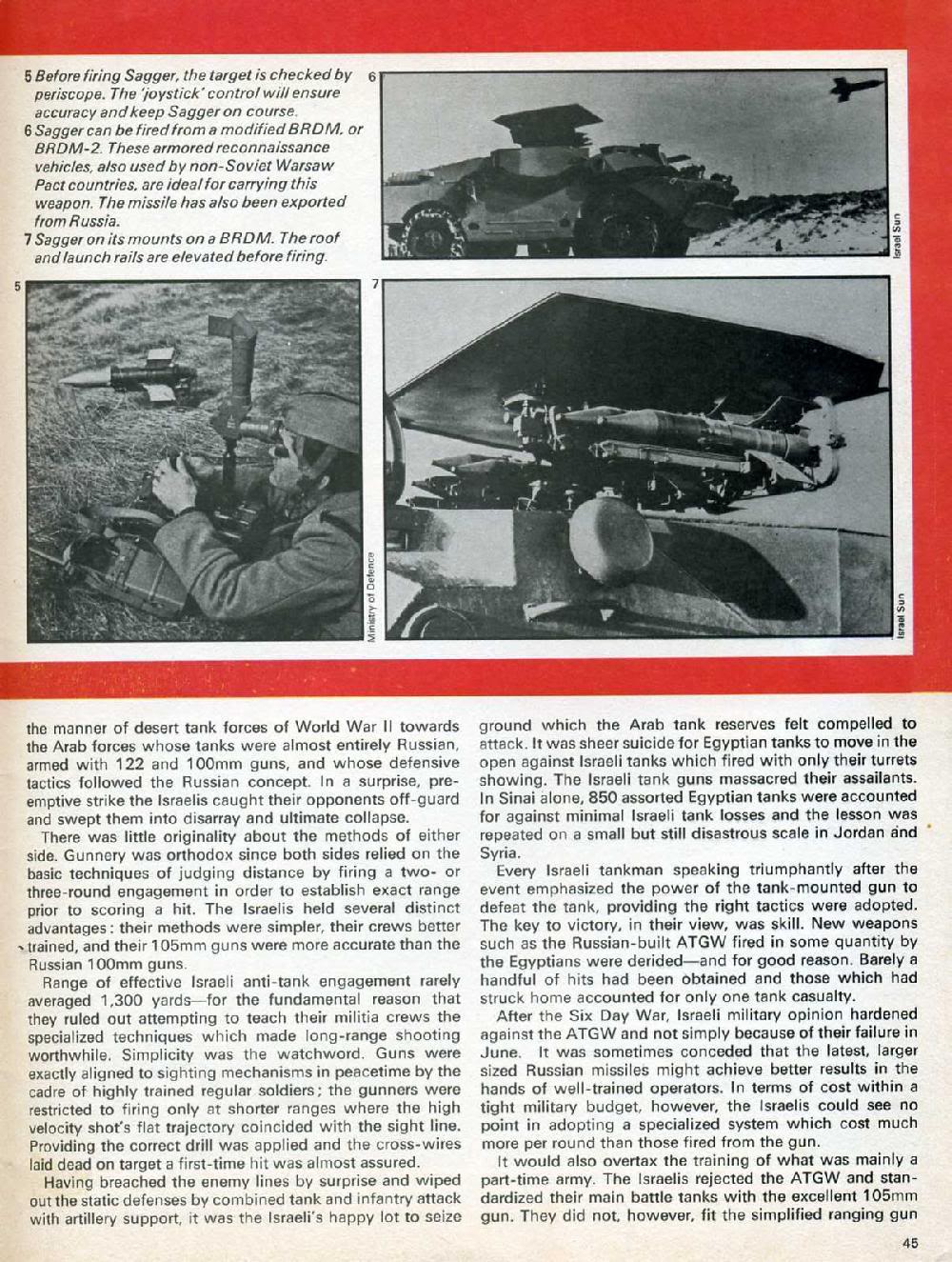
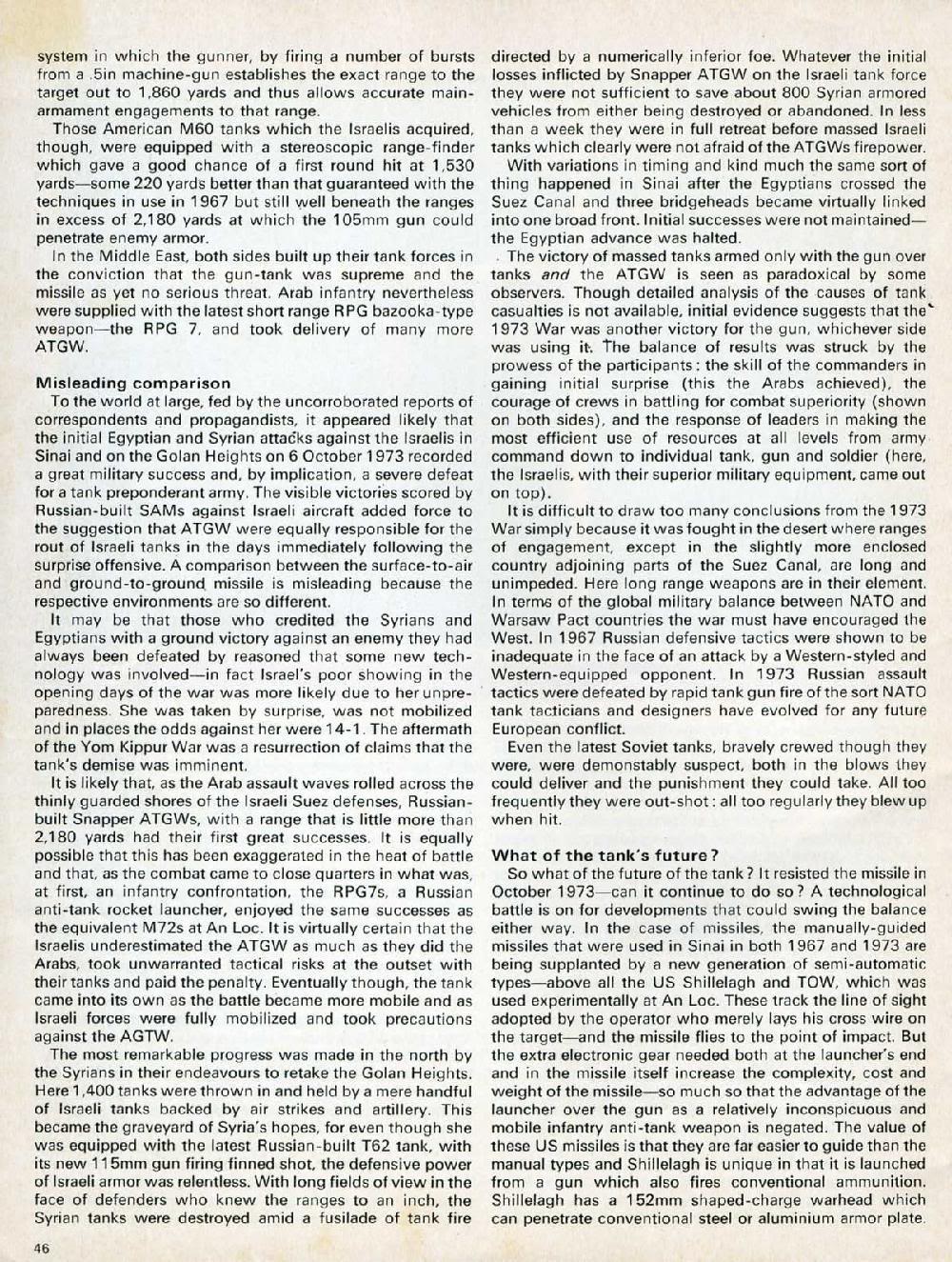
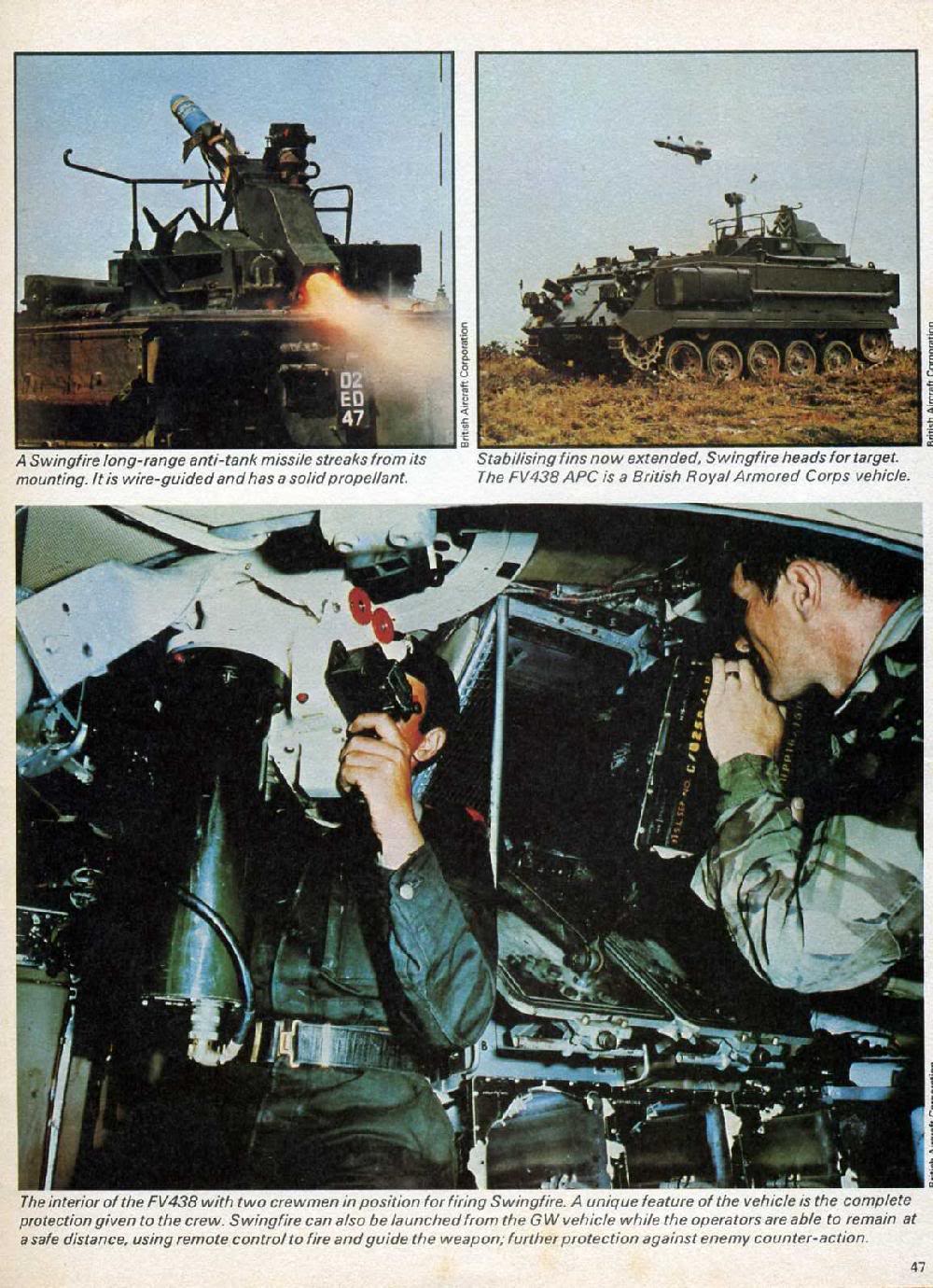
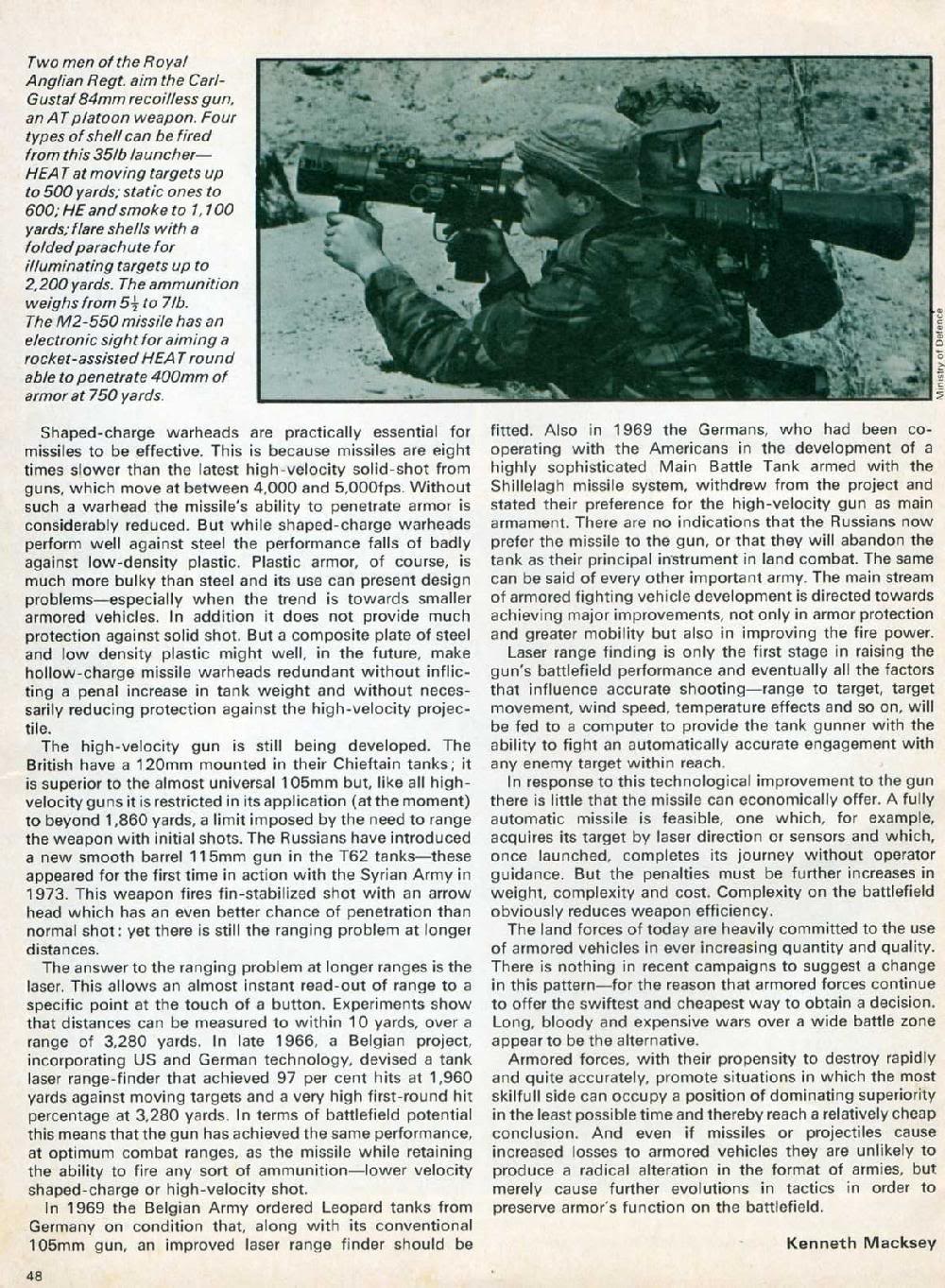
Humvee Trucks Warned Vulnerable in 1989
Replacing the Humvee with another wheeled truck the JLTV is unaffordable and absurd. All because of light infantry narcissistic vanity to not be seen in a track.
This must end and it must end now.
We can ill-afford to squander 28% of our armor and weapons potential by using wheeled trucks that are road and trail bound:
www.combatreform.org/infantrytanks.htm
LIGHT infantry needs to be MOBILE and ARMOR PROTECTED in LIGHT TANKS.
The solution: M113 Super Gavins NOW
The good news in all of this repetitive disaster is that there is a sub-unit of every Army light infantry battalion that has to use Humvee trucks to move around their heavy TOW ATGMs to get a 3.75 km stand-off against possible enemy tanks as well as move too heavy for practical man-pack .50 caliber and 40mm heavy machine guns: the "Delta" weapons companies. By simply re-equipping them with M113 Gavins, these units can become "Dragoon" Weapons companies with each track having space in back to transport A, B, and C rifle companies as needed:
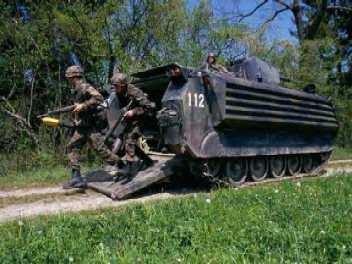
www.combatreform.org/itmaneuversabattalion.htm
Only the Dragoons would have to maintain their Gavins and advanced Super Gavins (band tracks, hybrid-electric drives, stealth camouflage, v-hull shaping etc.)--A, B, C and HHC companies would still have to stay skilled in dismounted warfighting skills.
The need for a small HE shell of comparable to the towed 37mm AT gun's we had in WW2 (!) to destroy small hardened targets can be better achieved today by a 30mm automatic cannon Remote Weapon System (RWS) on top of our Super Gavins in a ready-to-fire condition not requiring Soldiers to manhandle them, though dismounted employment is still an option. With a high-rate-of-fire and a devastating effect, targets up to light armored vehicles and car/truck bombs can be exploded with HE effect. All of this possible by stabilized, fire-on-the-move that is PRECISE so we only kill identified bad guys--not civilians. The armor protection of the Super Gavin provides light infantry the ability to absorb some enemy fires and figure out where its coming from--not desperately fire in all directions as is common when exposed on foot.
For a large HE shell effect akin to the larger WW2 AT guns that also blasted bunkers and urban positions, a "dumb TOW" ATGM with a HE--and not an AT--warhead can be fired by the Dragoon company; and attached A, B, C company infantry could connect their Javelin ATGMs or M3 Carl Gustav 84mm RRs to the Super Gavin roof to fire them from a special blast-deflector mount and/or fire the AirTronics Amerikansky RPG-7 using rounds that they capture back at the enemy. A simple roof-mounts for their M240B 7.62mm MMG, M249 LMG and 60mm mortars would be fitted. In other words, when A, B, C companies hitch a ride with Dragoon company in their Super Gavins, their organic weapons don't have to sit at their feet as they get tossed around in back waiting to dismount--they can add the weight of their fires to the fight while MOUNTED, so they can prevail to reach the dismount point; before, on or beyond the objective.
NOTES
http://en.wikipedia.org/wiki/3-inch_M1918_gun
http://en.wikipedia.org/wiki/QF_17_pounder
http://en.wikipedia.org/wiki/M18_Hellcat
